Back to the Future
It is the year 2073. I am in Kathmandu, a city at the top of the world where old hippies go to die. Okay, it’s still 2016 by the Gregorian calendar, but Nepal and much of Hindu India uses the Vikram Samvat lunar calendar, so the date is accurate. A year after the devastating earthquake of 2015 the city was still in the process of recovering and rebuilding. Barely a mile from Thamel (the busy tourist heart of Kathmandu), makeshift shanties crowded the banks of the Bagmati River, acres of corrugated metal and cardboard roofs amongst the mud and detritus. Around Thamel an endless stream of trekkers, gap yahs, backpackers, latter-day freaks and the odd touring cyclist squeezed through a vascular web of medievally narrow streets, jostling for space between motorcycles, rickshaws, random sacred cows and preposterously oversized Land Cruisers.
My host in Kathmandu was Pushkar Shah, a legend in touring circles and throughout Nepal for his epic eleven-year, round-the-world bicycle trip, visiting 150 countries to bring a message of peace from Nepal, and ending with summiting Sagarmatha (Mount Everest). My heart was set on a long hike in the Khumbu region of the southern Himalayas, home to Sagarmatha National Park and four of the ten highest mountains in the world. My side trip to Sikkim had put me behind schedule, the pre-monsoon rains were already falling on the plains. To have travelled all this way only to find the peaks shrouded in low cloud would be heart-breaking. Pushkar graciously agreed to look after my bike and belongings while I was away, so I determined to grab the necessary trekking gear and permits and get going.
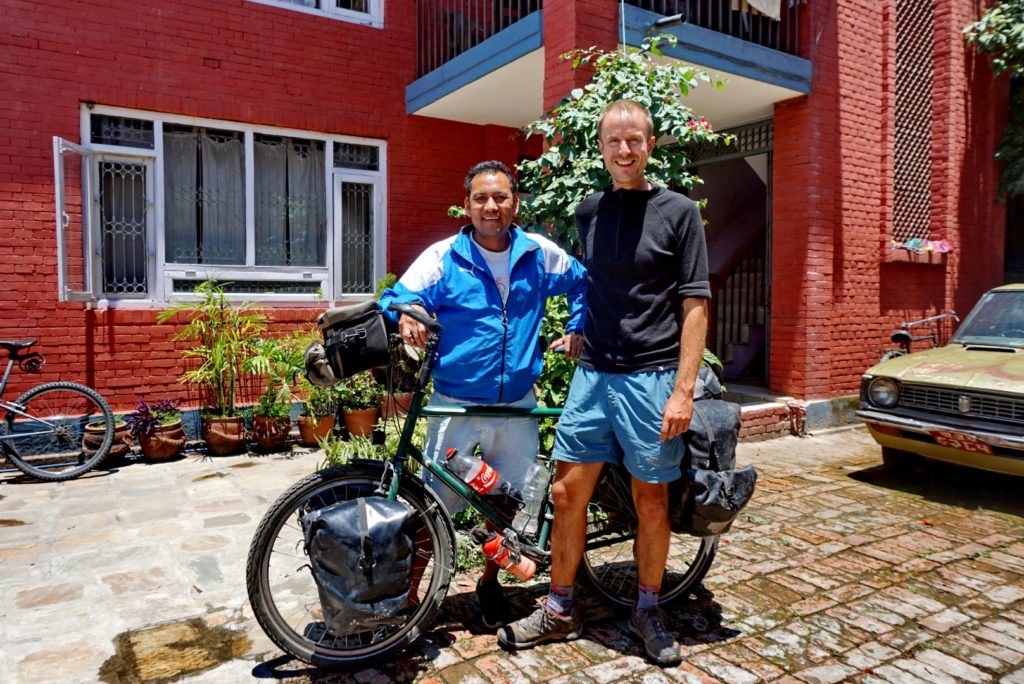
Bus timetables in Nepal are purely aspirational; the six-hour journey up to Jiri took nine. The packed charabanc laboured up and down switchbacks through the Himalayan foothills, Indian electro-pop music turned up to full volume, one CD on repeat the whole journey. My seat-mate was a small, neatly-dressed, Nepali woman who suffered terribly from motion sickness, a common complaint amongst the mountain folk. Throughout the trip she demurely chundered into plastic bags, which she surreptitiously discarded out of the window. Cramped, sweaty and half deaf by the time the bus wheezed into Jiri, I jumped off like a man leaving a burning building and bounded for the trail head. 90% of trekkers fly from Kathmandu to the high airstrip at Lukla, but when the British Expedition made their approach to Everest in 1953 they started here. New roads are penetrating like tendrils into the valleys of the Southern Himalaya, extending further every year. But if Jiri was good enough for Hillary and Norgay then it was good enough for me. I would follow their footsteps as far as Namche Bazaar, then make a circuit of the ‘Three Passes’ with a side trip to Everest Base Camp, before walking out through the eastern valleys towards Tumlingtar – chaining three classic routes for the price of one.
My 12kg pack did not stretch to camping equipment. I preferred instead to travel fast and light between overnight stays in the many teahouses (basic lodges) that line the trails. Walking hard that first evening I reached the hillside hamlet of Malli, narrowly dodging a torrential downpour. Immediately I saw that the lodge there had been razed by the earthquake, the roof caved in, walls leaning precariously. A few Nepali men stood around watching me with a bemused air. One told me he was the owner of the lodge and I could sleep there for free if I wanted, before emitting a belly-laugh and shaking his head wistfully. Another told me that there was no problem, I could either sleep in the shed that he and seven fellow construction workers occupied, or if I preferred alone in the almost-complete maternity hospital they were building. To the dismay of the talkative foreman I chose the latter.
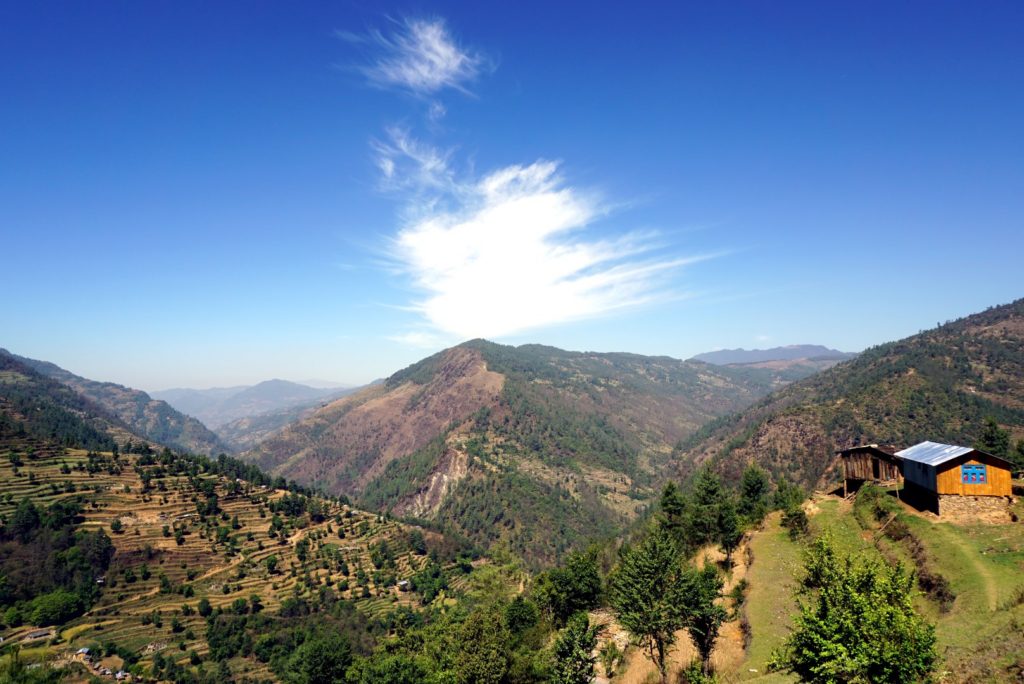
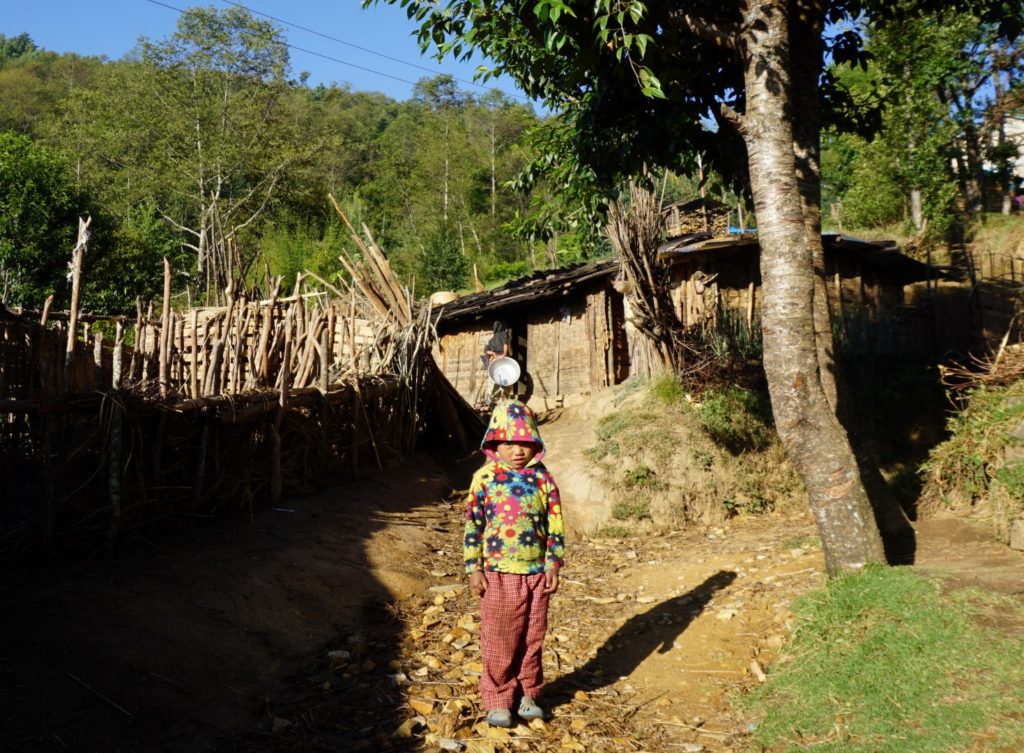
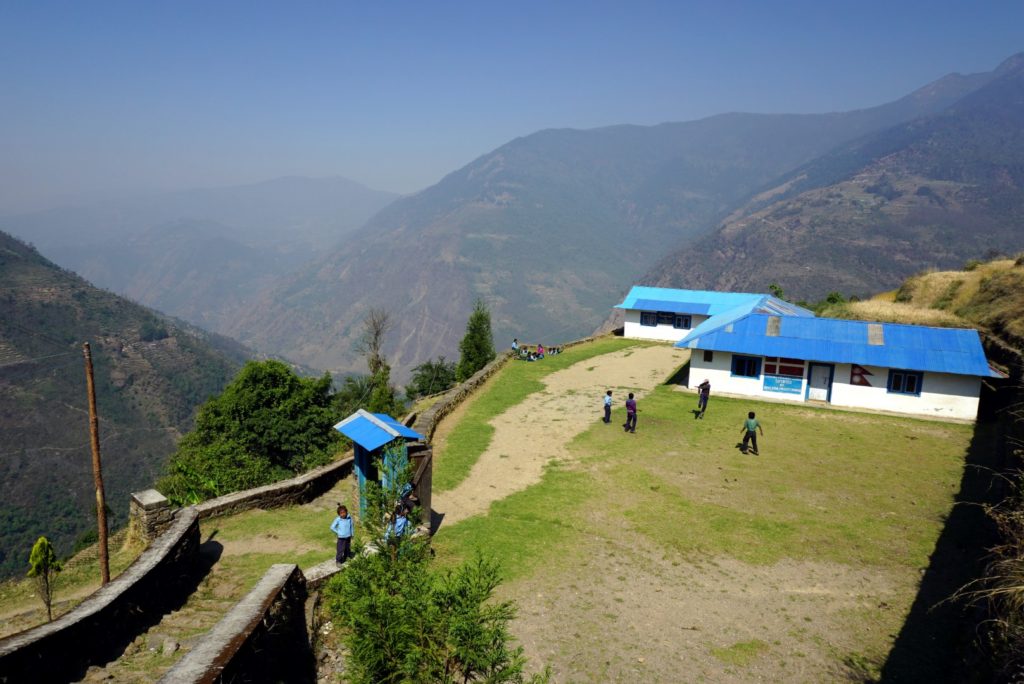
Over breakfast in Shivalaya I chatted with the friendly café owner, who piled on extra porridge and chappatis for me when he heard I’d walked from Jiri the night before. Tourism had taken a knock everywhere in Nepal since the earthquake, out here in this unfashionably remote corner of the mountains footfall was particularly low. In the next three days I saw only a handful of other trekkers. Of the six or seven lodges in the village of Kinja only two were now functional, stones from demolished buildings piled up around exposed foundations like archaeological excavations. In these ‘teahouse’ lodges, tiny wooden partitioned rooms with a sponge mattress and blanket were available for next to nothing – often at no charge if you bought all your meals there. Dhal baht (rice and thin lentil curry), porridge, apple pancakes and instant coffee were the staples; seldom appetising but essentially sustaining.
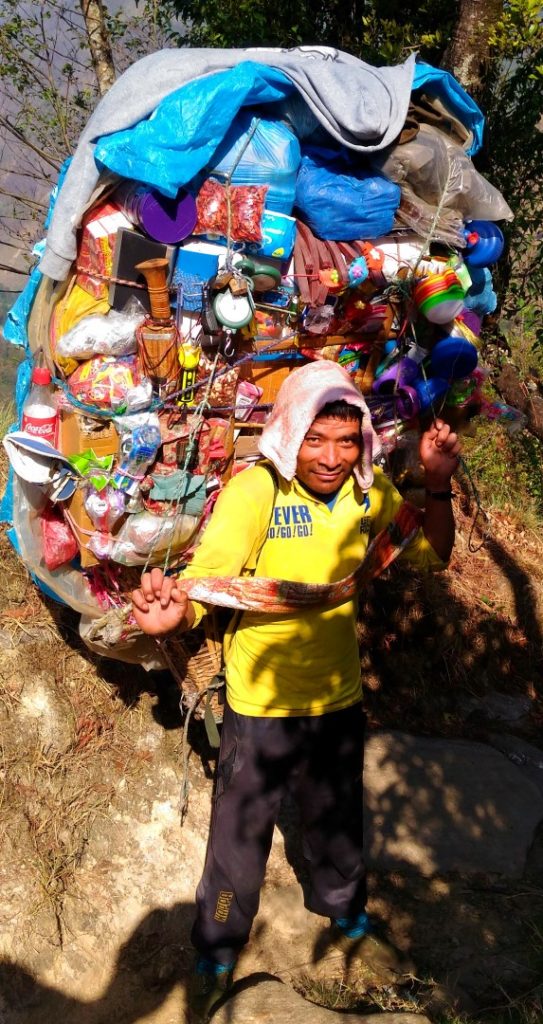
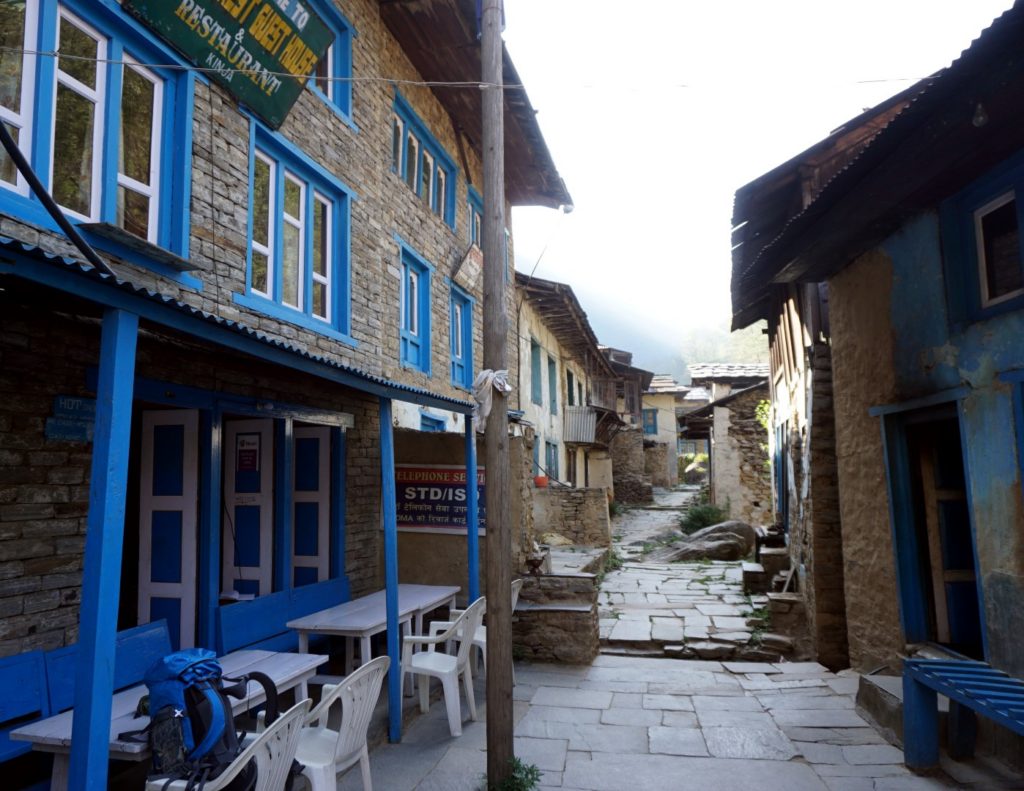
On the Lamjura Pass, between flowering rhododendron trees I got tantalising early glimpses of the giants to the north, along with a foretaste of the perils of ascending them too rapidly. At just over 3000m, this pass was high enough to put the hurt on and I was glad to get down the other side. By the third morning, the hard walking (43km of constant climbing and descending) was starting to take its toll on my body. After being so long on the bike, I was unaccustomed to footslogging. The long rocky descents were most punishing of all. Several hotspots on the soles of my feet threatened to become blisters, so an easy day was in order to recover and hopefully prevent my battered feet from becoming a liability that could ruin my trek.
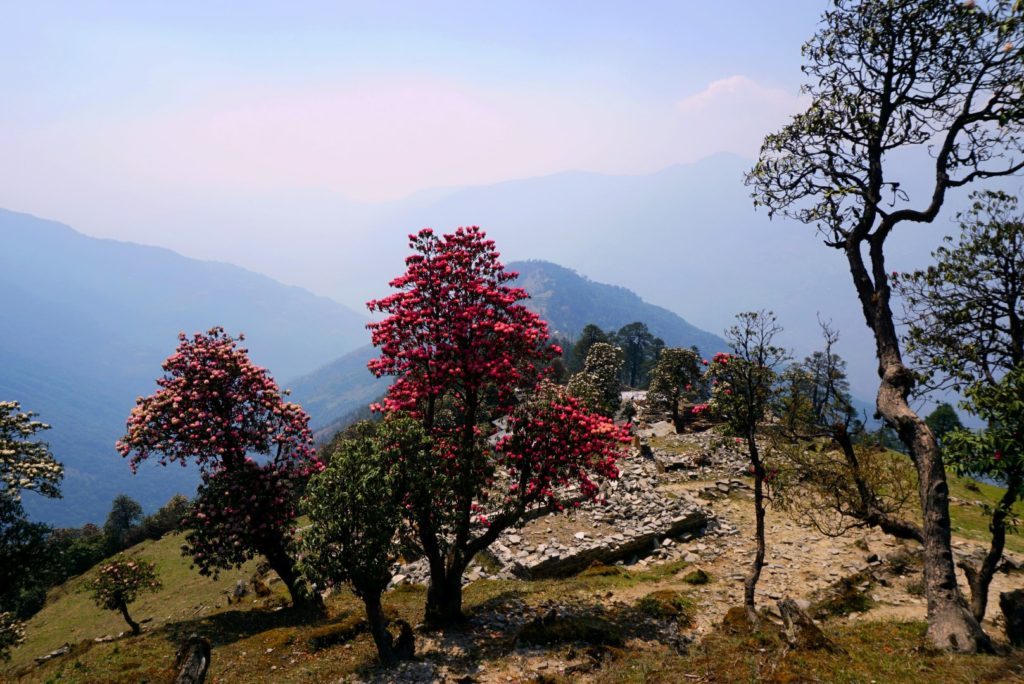
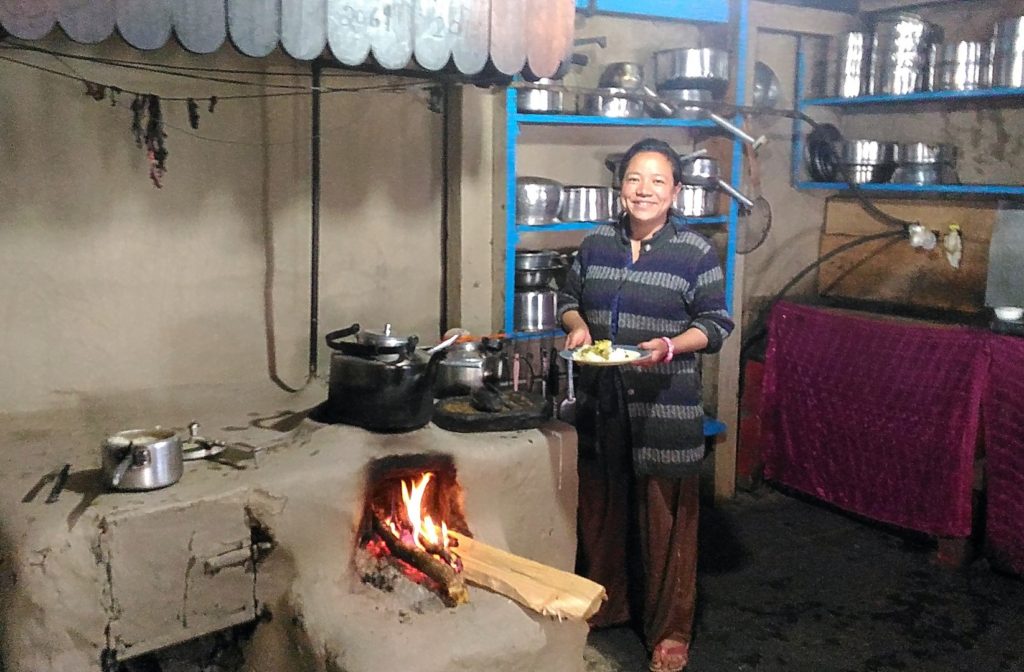
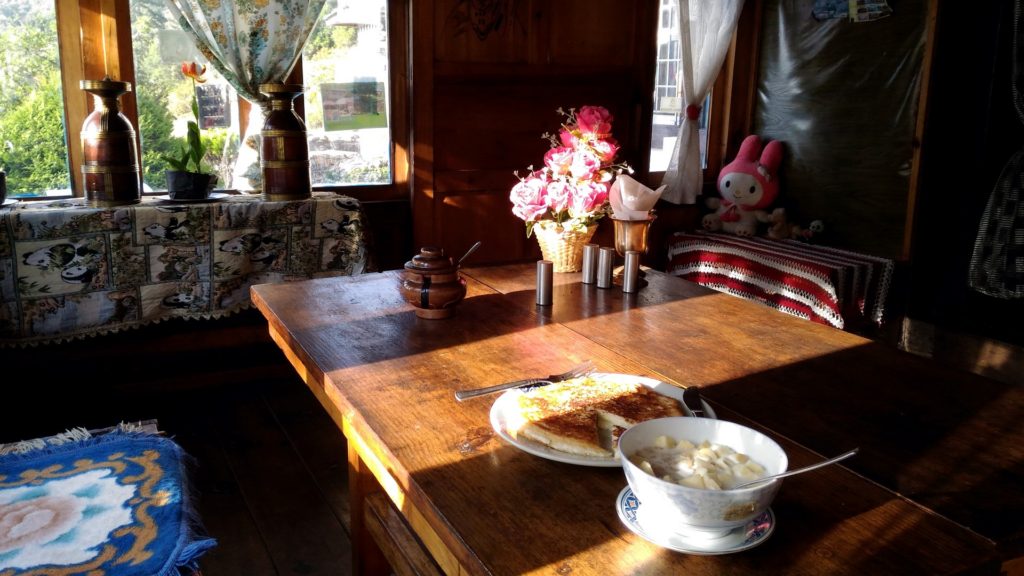
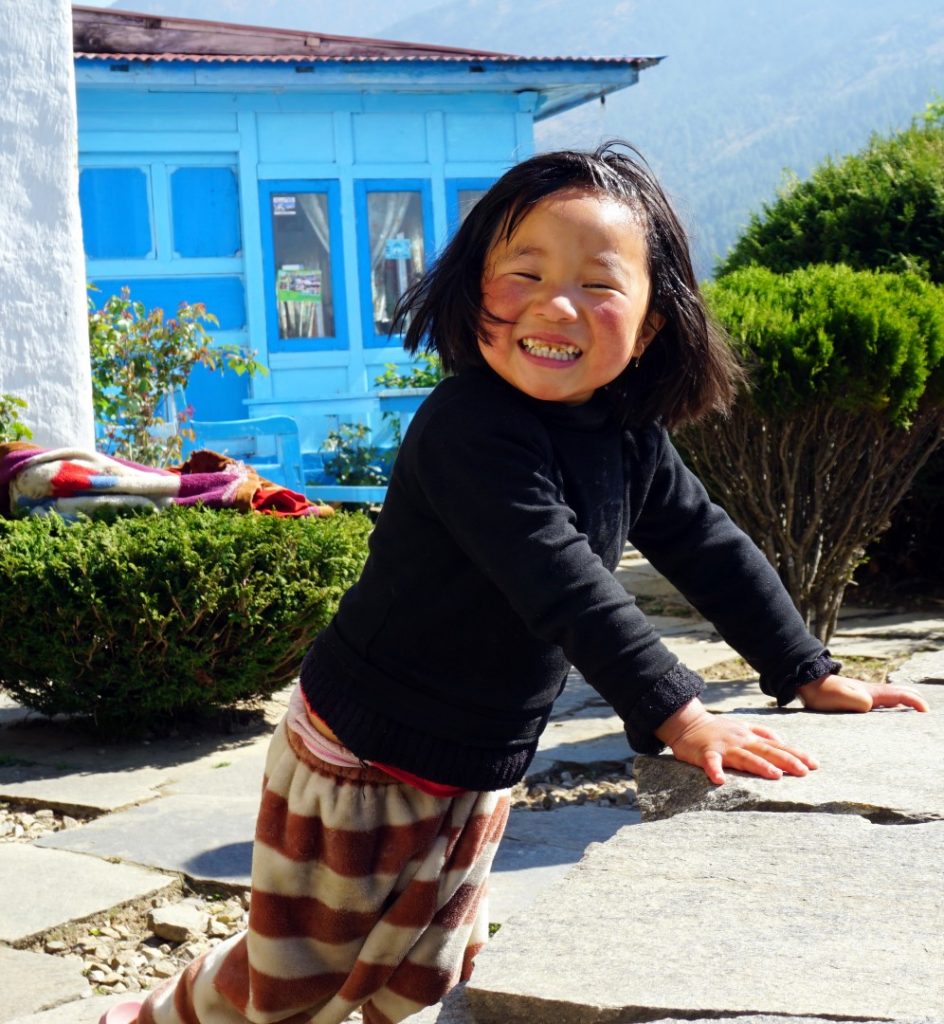
Wandering through sub-Alpine woodland I savoured the tranquility for one more day. East of here the path would become progressively busier with mule trains and time-strapped trekkers joining the trail from the airstrips at Phaplu and Lukla. I encountered an elderly, yellow-robed Tibetan monk coming down the mountain from a side trail with his porter in tow. Wisps of his white beard and eyebrows blew like cirrus clouds from beneath the enormous brim of a floppy yellow hat. A more quintessentially Tibetan figure you could not imagine, but he hailed me with a croaky James Stewart drawl that gave away his origins. This Lama Konchok had first come to the Khumbu fifty years ago as an ambitious young American climber, putting up new routes and chasing impossible dreams. Luckily for him he met his spiritual guide before the mountains killed him, and he became a follower of the Middle Way. He sagely advised against my planned anticlockwise circuit of the Three Passes, pointing out that I would be forced to acclimatise with the marauding hordes in packed lodges all the way from Namche up to Base Camp. Better to go against the flow, he proposed; acclimatise in the less-travelled western valleys and leapfrog the crowds on the way down. This affable wise old man of the mountains crossed my path three more times in the days that followed. For a man in his late seventies he travelled at a remarkable pace, arriving in Namche Bazaar only a day behind me.
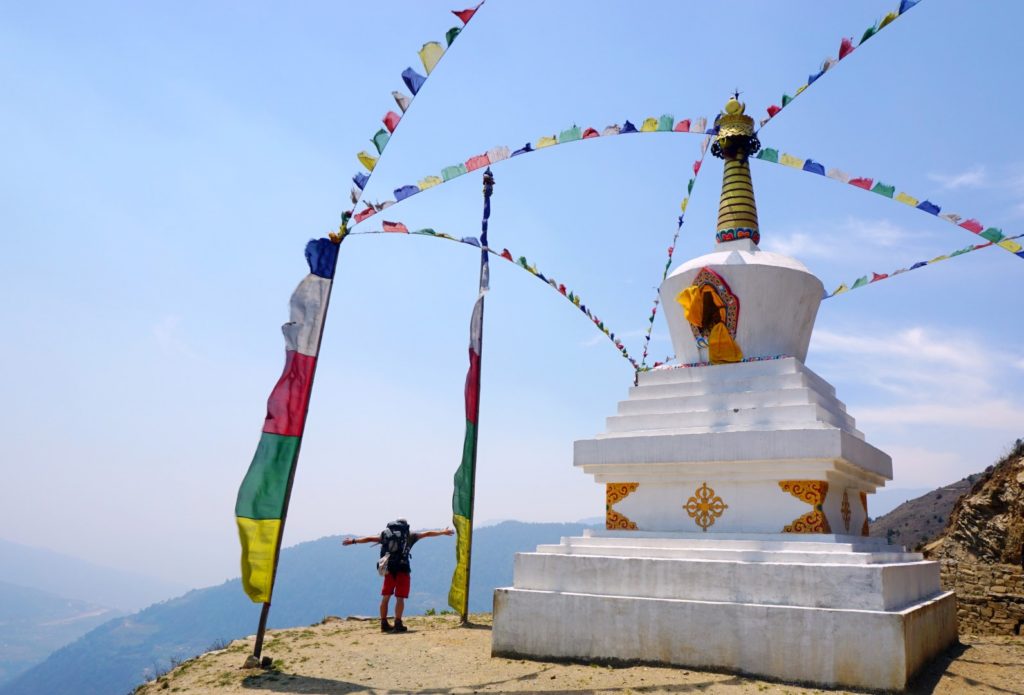
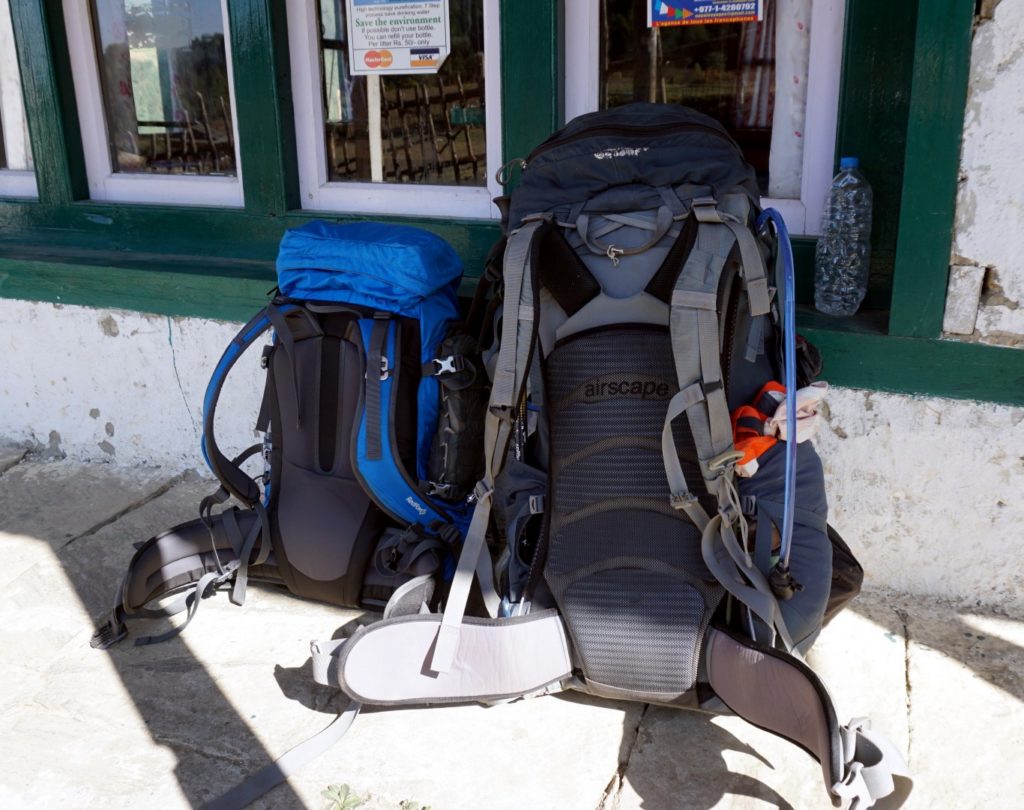
On the steep descent from Trakshindu La pass – one-and-a-half vertical-kilometres down to the Dudh Kosi river valley – I met for the first time trekkers returning from the popular Base Camp trek. A friendly Swiss hiker told how spectacular were the mountains ahead, but bemoaned the continuous climbing and descending of the trail. “In Europe the trails are much more logical. Once we go up we stay up until it is time to come down. Here, up and down every day!”. Later a German trekker enthused about the hike he was returning from, but his trail-mate was of less cheery disposition, crowing about having done the Three Passes twice now in both directions, but that “Pakistan is where the real scenery is”. Uh-huh, whatever. In Bupsa, amiable mountain guide Pemba Jangbu Sherpa buzzed around his family’s lodge, fussing over wealthy American client, Reuben. A Seven Summits bagger (the highest point on each continent), Reuben was now seeking, with Pemba’s assistance, to add K2 to his tally. With bodybuilder physique, he thrust his business card into my hand: ‘Powerful Human’ it proclaimed. I stifled a gasp of astonishment at the overweening hubris of it, but he wouldn’t have noticed, consumed as he was updating his social media accounts on his smartphone. High five!
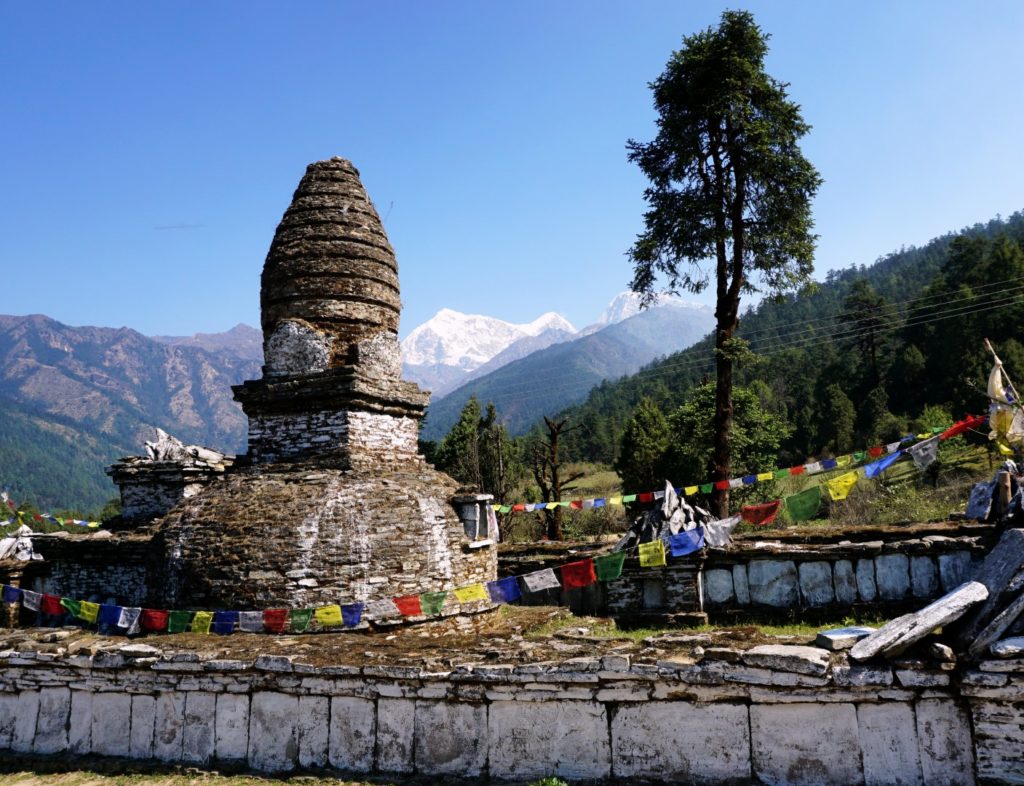
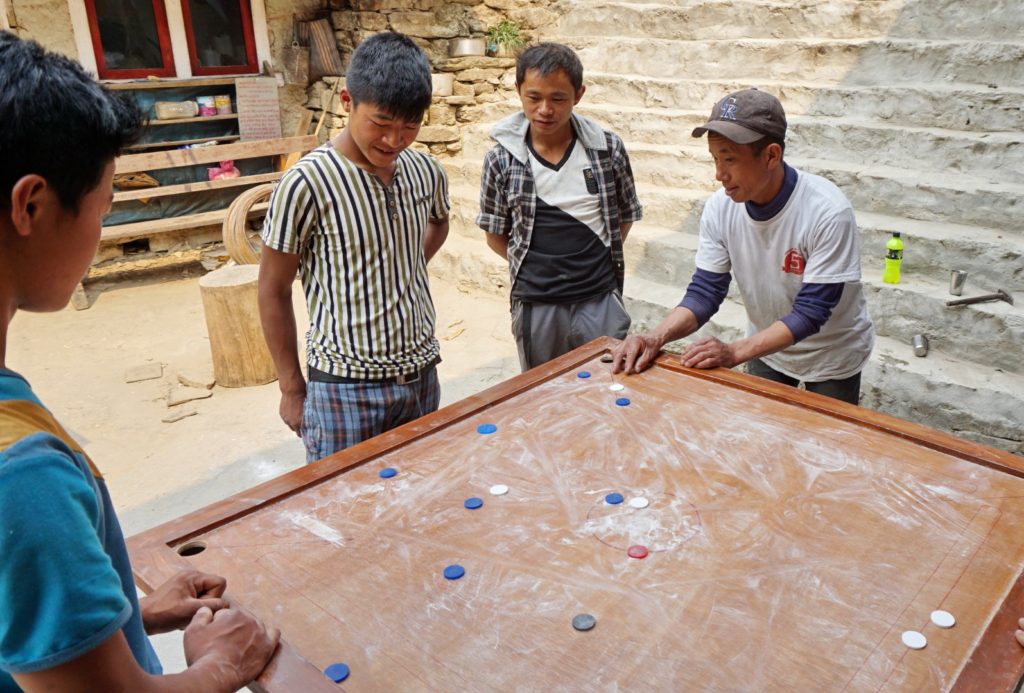
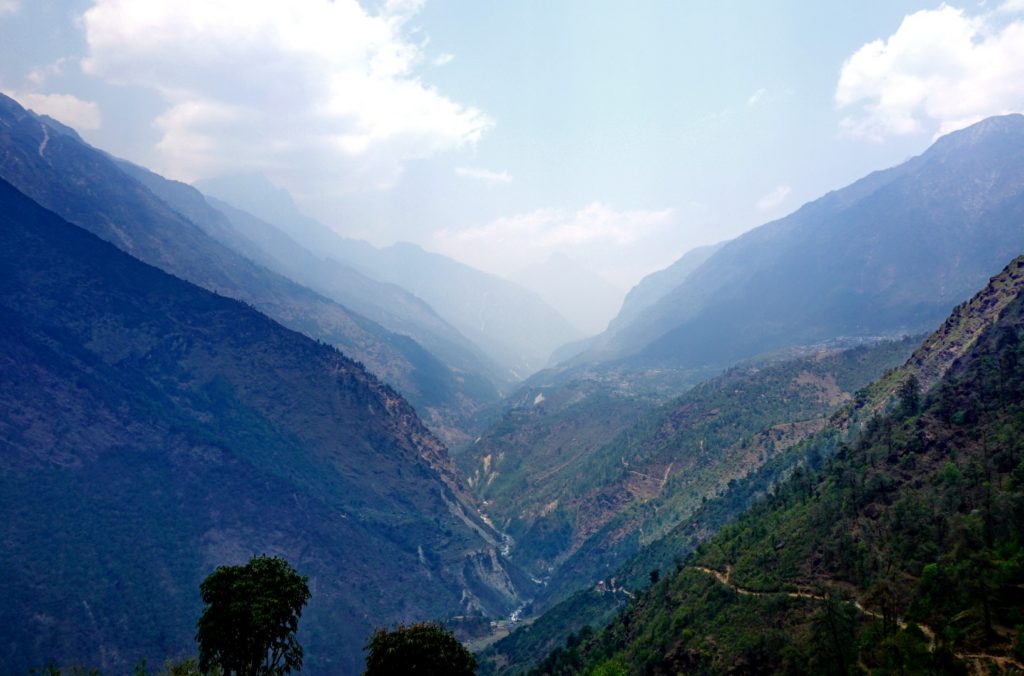
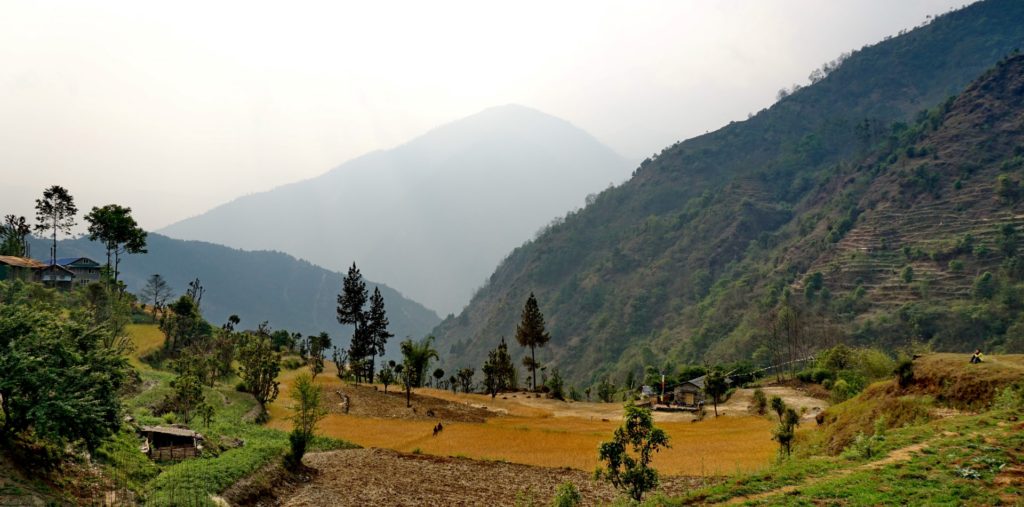
Past the turn off to Lukla the real circus began. As I ate lunch & aired my feet in Cheplung they shuffled glumly along behind their porters in herds by the dozen, all clattering walking poles and ill-fitting mountain boots. Maybe two out of a hundred returned my greeting, and I realised the wisdom of Yoda Konchok’s advice to give a wide berth to the main ascent route to Everest Base Camp. In every teahouse I was asked, ‘where is your guide? Where is your porter?’ Most mountain guides treated me warily in front of their clients, apparently viewing unsupported trekking as a professional affront, although privately they were usually personable and helpful. I chatted with a porter who was hauling three bulging duffle bags lashed together and suspended from a tump-strap around his forehead, a load of easily sixty kilos. His two European employers strolled along behind with their guide, each carrying only a bottle of water and pair of sunglasses. I could just about keep up with the wiry little porter, my Vibram-soled trail shoes outgunned by his carpet slippers. He told me that he carried loads from Phakding to Namche every day, pocketing $10 for the return journey, all of which he gave to his parents to buy food and fuel for his family. He was chatty and alert, but he was not happy with his lot. Other non-trekking porters carried even greater, improbably unwieldy, loads.
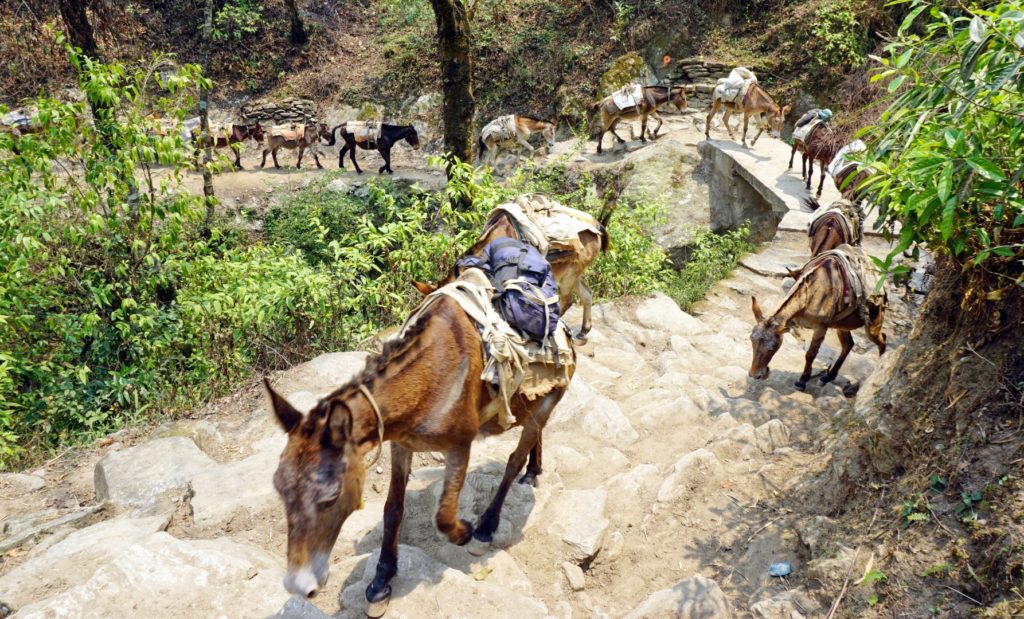
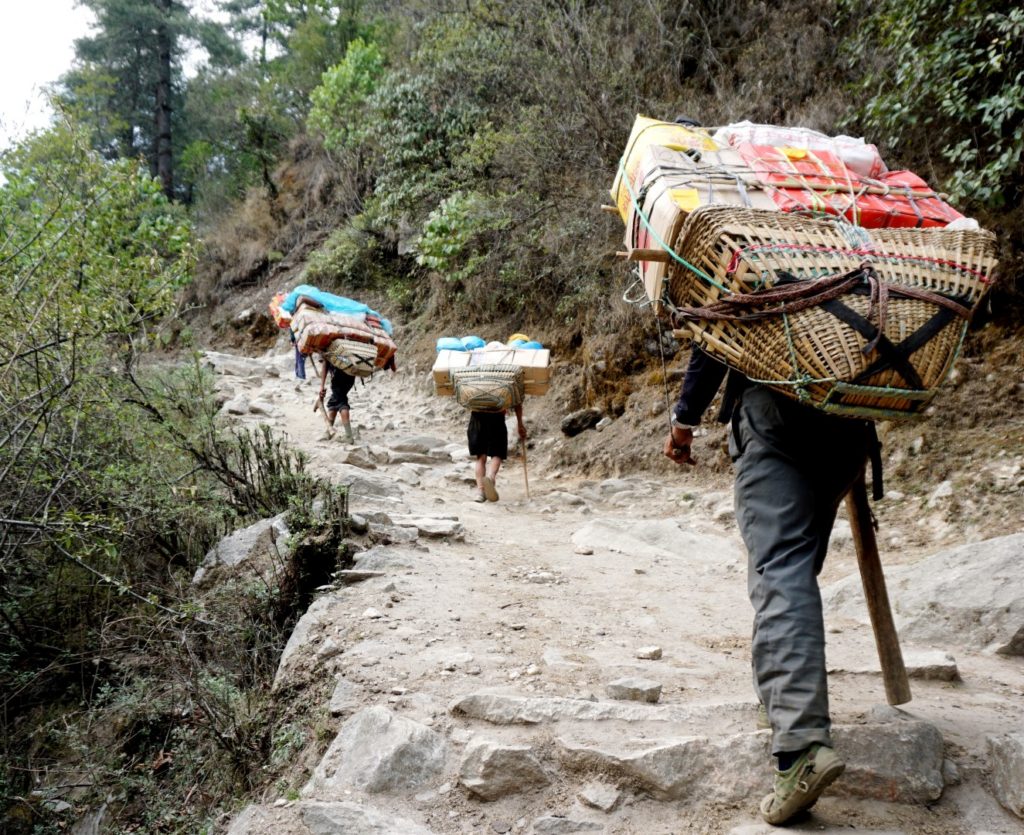
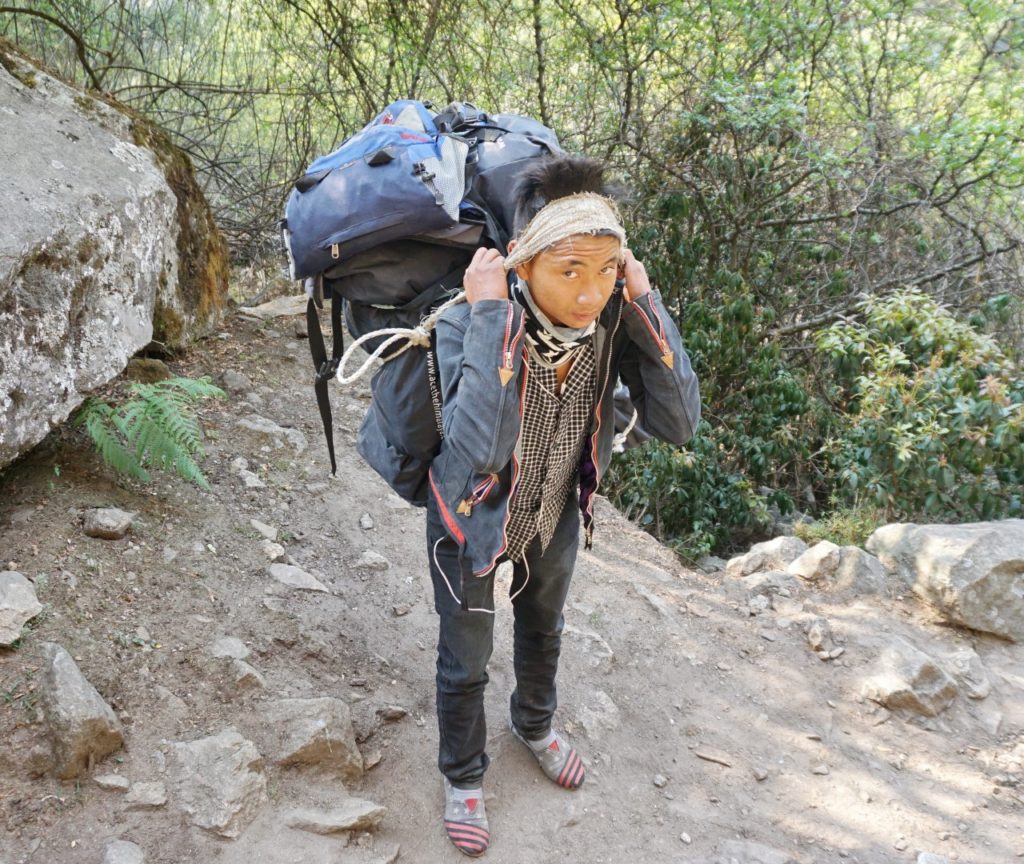
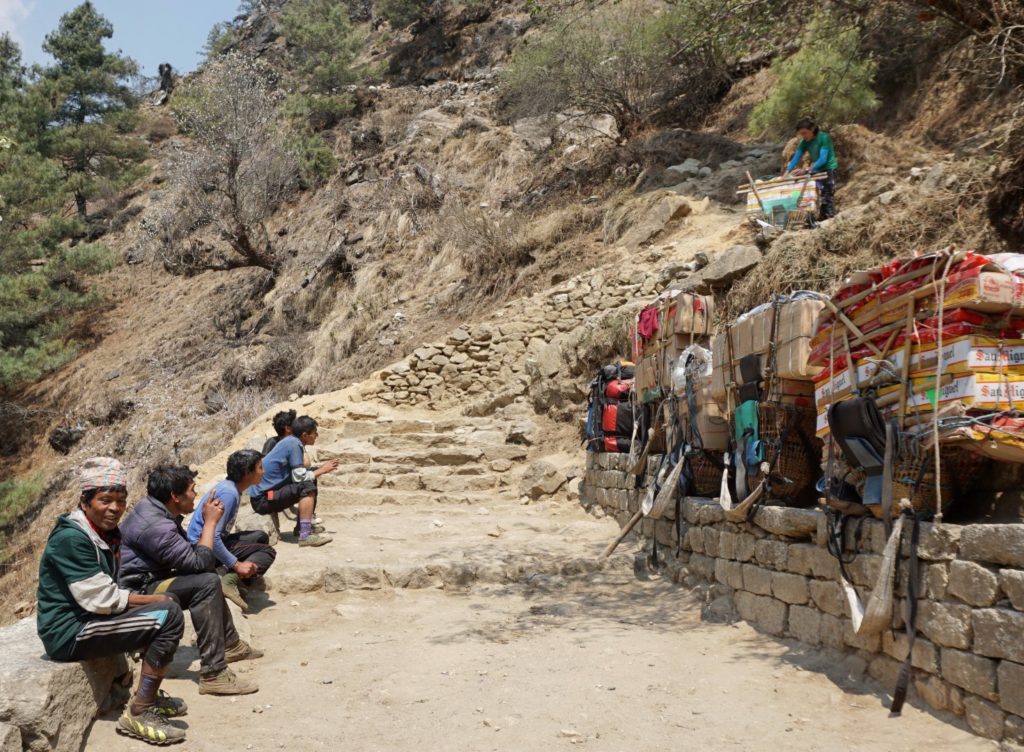
Above Phakding I bumped into Norwegian Phillip, conspicuous among the advancing throng for carrying his own gear. Together we bounded up the Dudh Kosi valley, the roar of the white water receding beneath us with each stride. Against a backdrop of 6000m-plus peaks, Namche Bazaar, the unofficial capital of the Khumbu, hangs in a natural amphitheatre at 3420m. There we scouted for digs for a few nights acclimatisation. Dawn to dusk Namche’s narrow cobbled streets echoed with the clink of stonemasons’ chisels, while yak and mule trains skittered on the steep stone stairways that formed the high street.
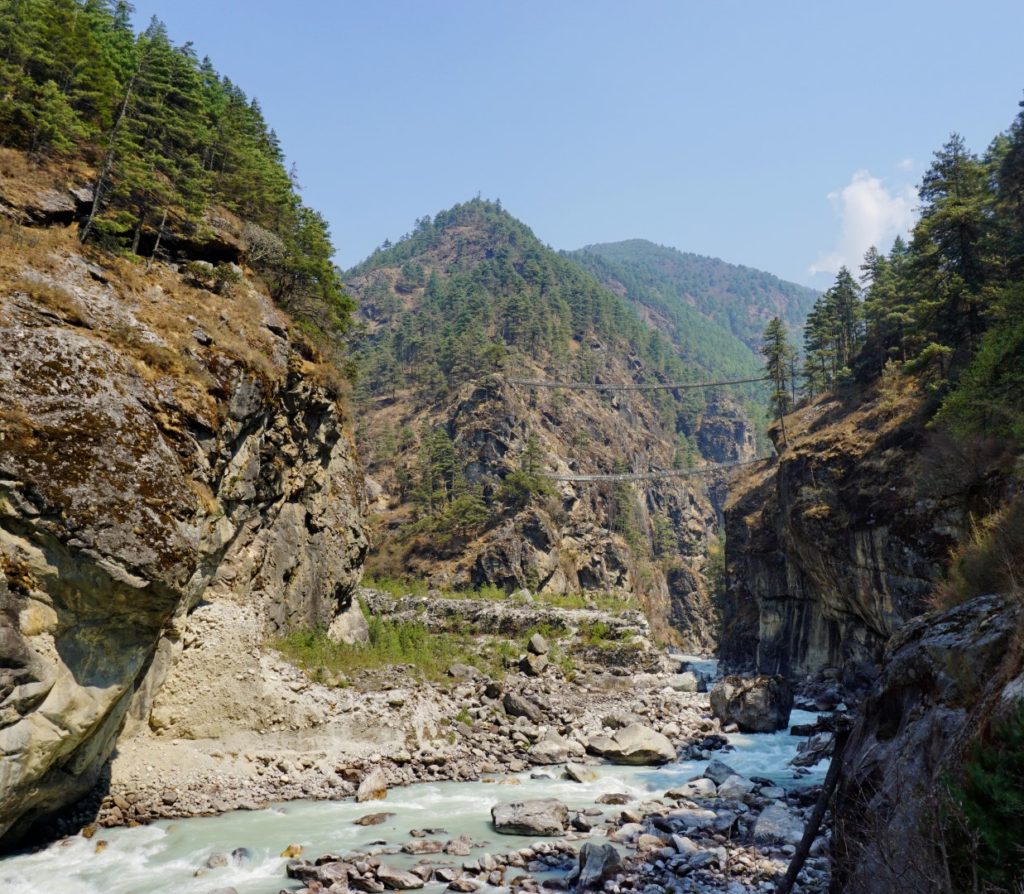
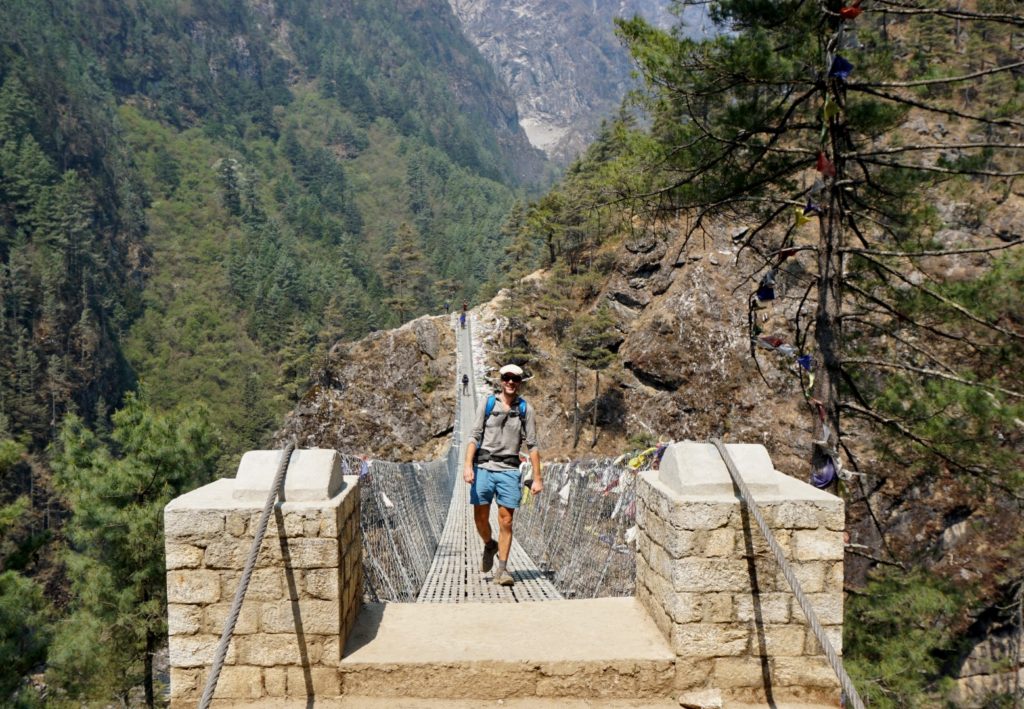
From a vantage point above the town, we got our first misty views of those iconic peaks: Sagarmatha, Ama Dablam and Pumori. I’d had a persistent headache since arriving in Namche – whether triggered by over-exertion and dehydration on the too-keen ascent or the beginnings of altitude sickness, I couldn’t be sure. I resisted the temptation to push on any higher with Philip, opting instead to lounge in Namche’s cosy cafes reading The Snow Leopard, Peter Matthiessen’s account of his part in a zoological survey expedition to the Crystal Mountain in Inner Dolpo in the Western Himalaya, shortly after the death of his wife. Matthiessen’s beautifully sparse prose, metaphysical reflections and raw emotion of being at the mercy of powerful elemental forces all resonated. While there was little prospect of seeing an actual snow leopard in the well-trodden valleys of the Khumbu, I did hope to experience something of the essence of these mountains away from the commercial apparatus of modern tourism.
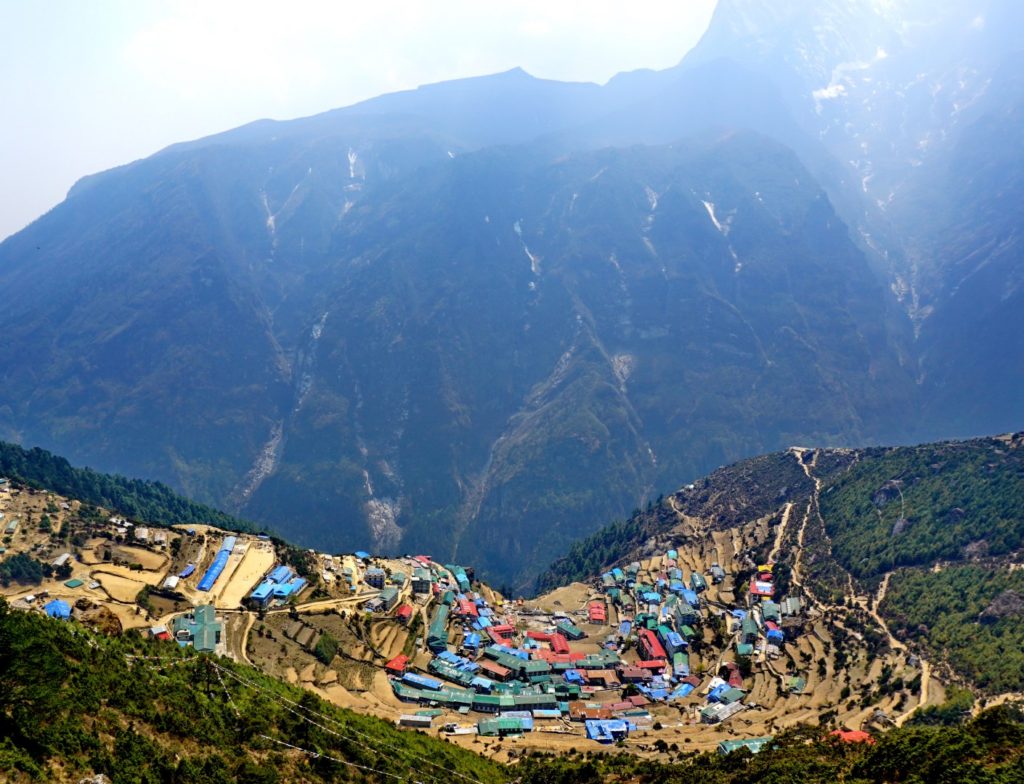
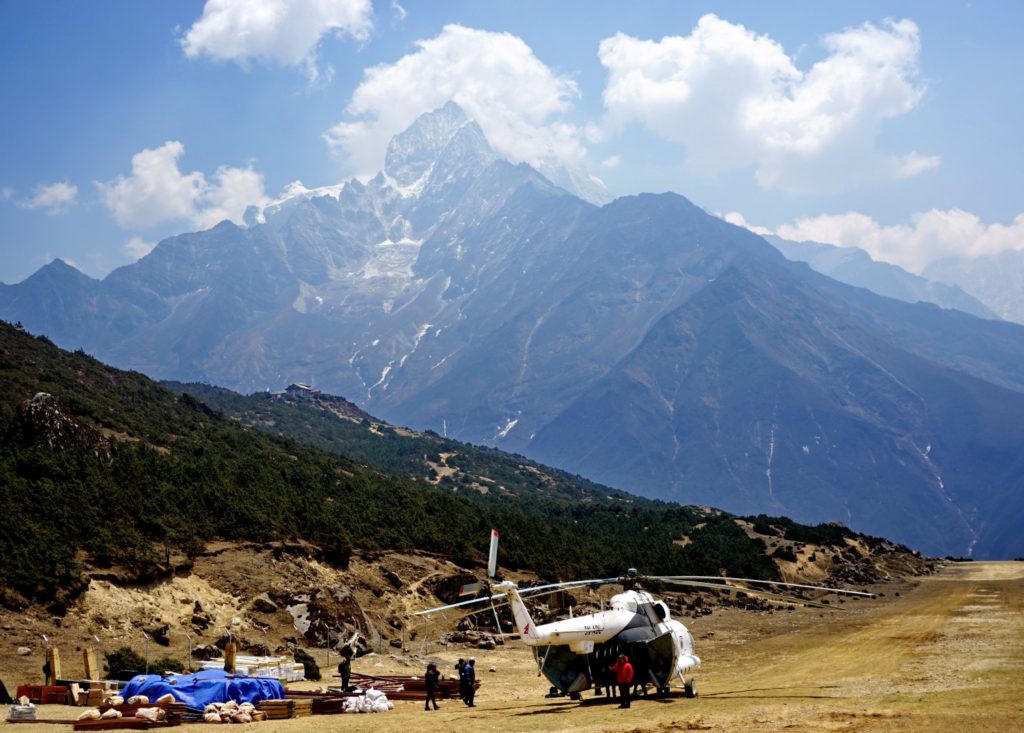
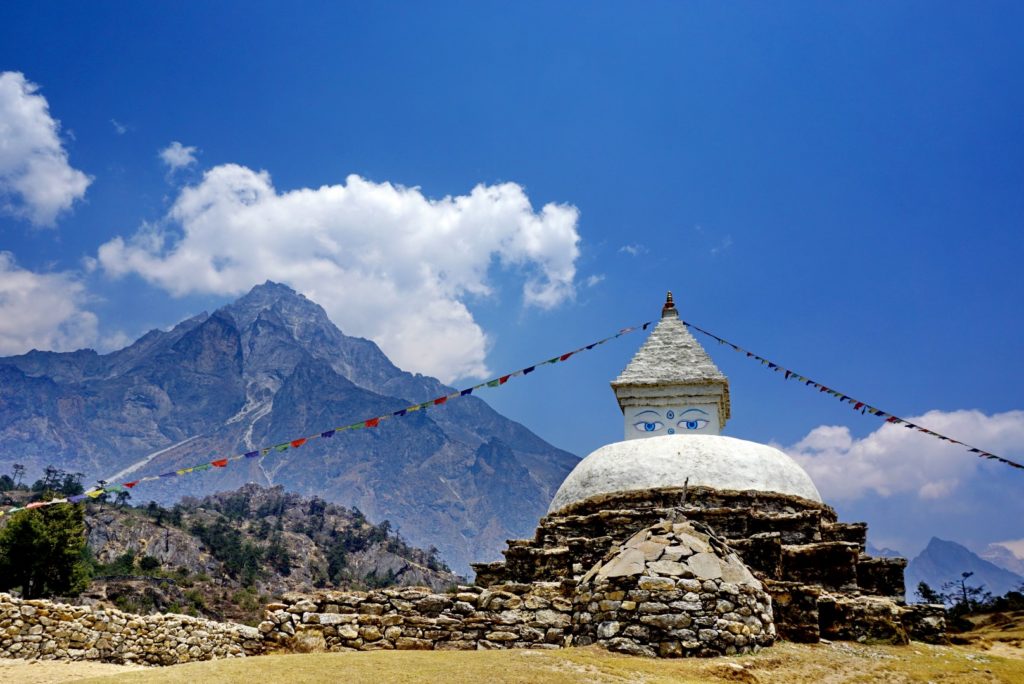
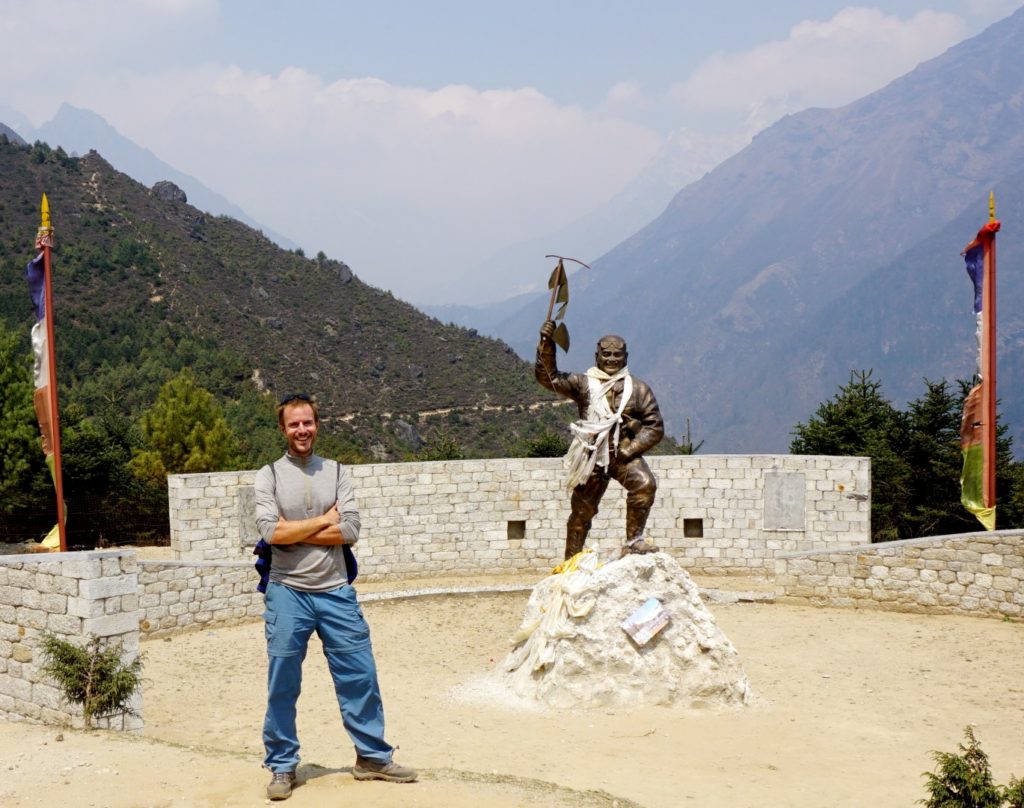
In the Sherpa village of Thame I picked a lodge at random, ate lunch and rested. Although lethargic I knew I would get more out of active acclimatisation (climbing high and sleeping low), so I roused my bones to climb the shoulder of Sunder Peak. Returning to the village by way of the precarious hillside gompe (monastery, literally ‘remote place’) I had the singular experience of sheltering from the wind with a young Buddhist monk watching Pirates of the Caribbean 2. Back in my lodge I chatted with other guests, most of whom seemed to be in some way connected with Apa Sherpa, the legendary climbing guide who has summited Everest a world-record twenty-one times. Only then did I twig that the discreet, smiley little chap who had brought my tea was in fact ‘Super Sherpa’ Apa himself, back in his home village to oversee some of the rural education programmes set up by his charitable foundation. Thame and neighbouring hamlets have produced a remarkable number of high profile Sherpa guides over the years. Their collective influence has surely benefitted the area in the wake of the 2015 earthquake. Thame was reportedly devastated by the quake, but almost completely rebuilt only twelve months later. Neighbouring villages were still clearing the rubble.
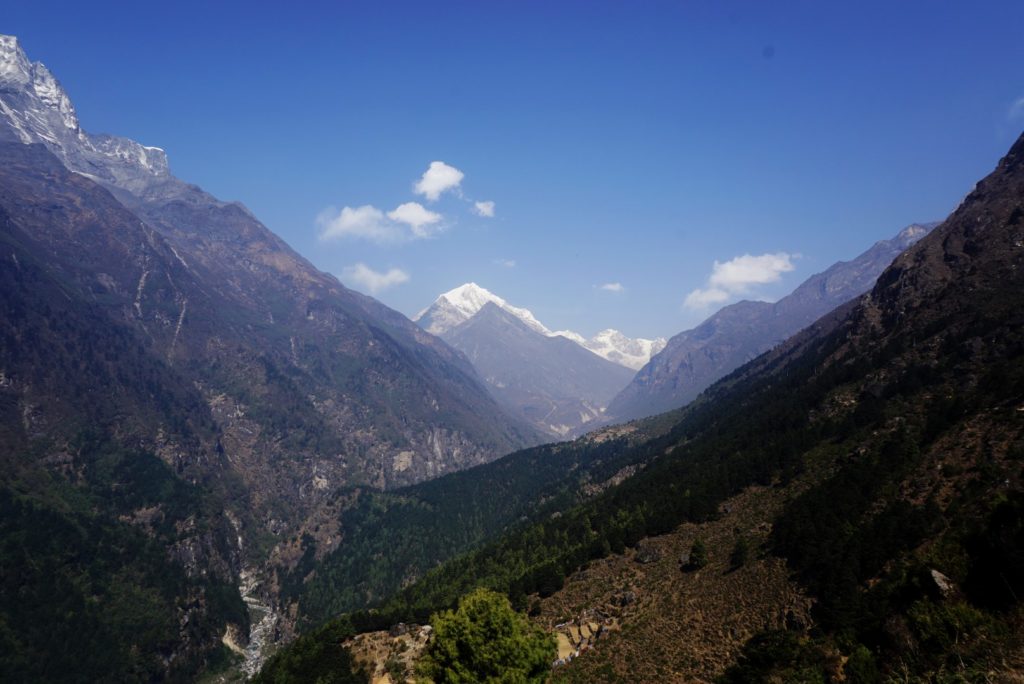
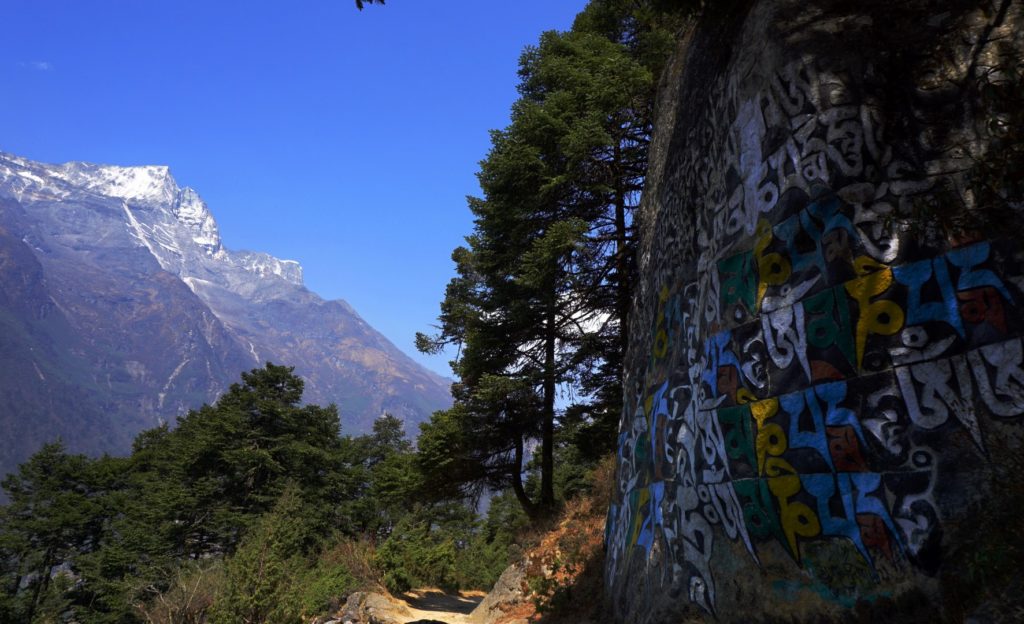


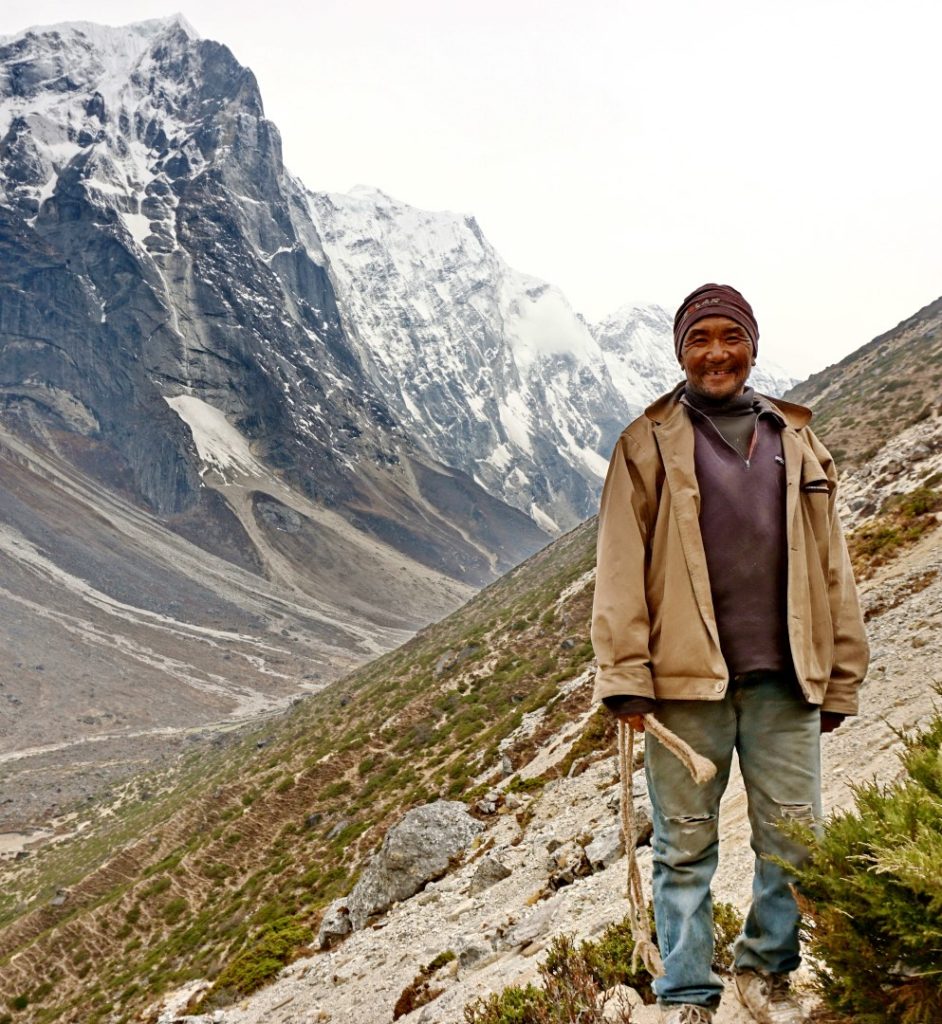
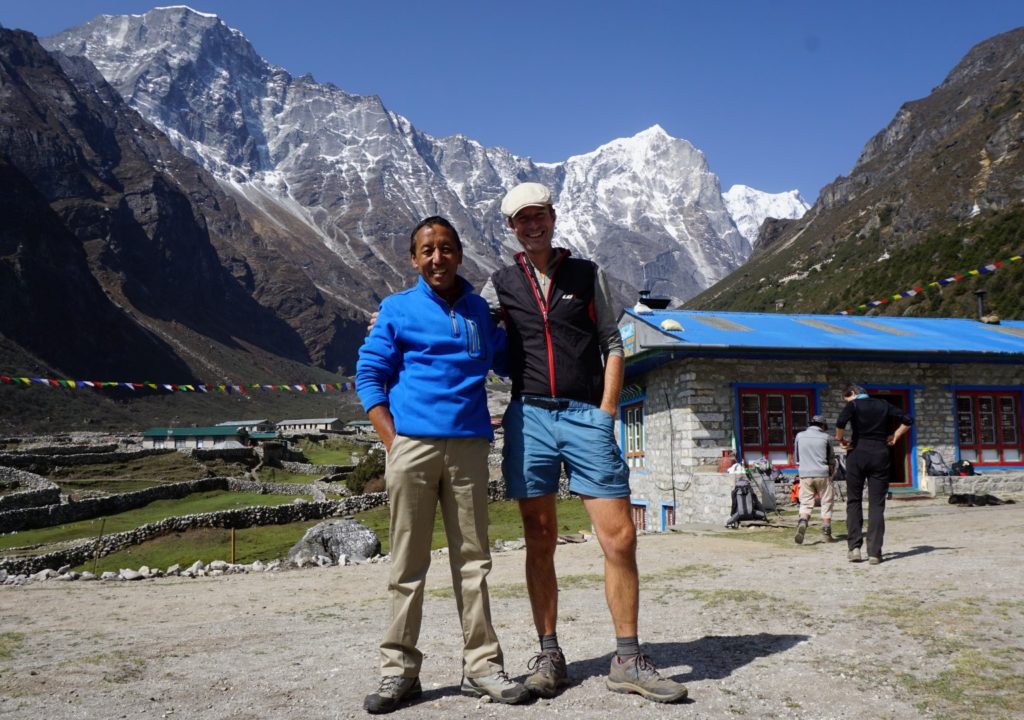
At the top of the valley loomed the 5345m Renjo La, the first of my ‘Three Passes’. Beyond the pass I would not sleep below 4200m for more than a week, so proper acclimatisation here was imperative before I committed myself to the high ground. I diverted from the main trail into the upper Bhote Kosi valley to the little-used homestead and lodge at Arya. Arriving half frozen by the bitter north wind that poured down off the Tibetan plateau, I was dismayed to see no welcoming thread of smoke from the chimney, the lodge apparently abandoned. A few desultory yaks stood about eking what energy they could from the frozen turf. I unlatched the gate and tried the door, which opened into a squalid hallway smelling of charred embers and old food. To my immense relief the owners were in residence, but the place was otherwise unoccupied. The owner, Pemba Nuru, nodded beatifically in response to my entreaty for food and lodging, while his twinkle-eyed Sherpina wife kindled a fire from dry twigs and yak dung. Pemba Nuru told me that he is a cousin of Apa in Thame, but compared to the fortunes of his famous cousin down the valley his plight was heart-rending. Pemba’s valley, once a popular stop off on the trade route through the Nangpa La pass into Tibet, was now a cul-de-sac since the Chinese closed the border there in 2012. He had a substantial herd of yaks, which had the run of the valley, but all was not well on that front either. His rheumy eyes moistened when I asked him about the logo of the Snow Leopard Conservation Trust on his baseball cap; had he seen one in these parts I asked hopefully? Only footprints, he said, but they prey on his yaks and he loses several every year.
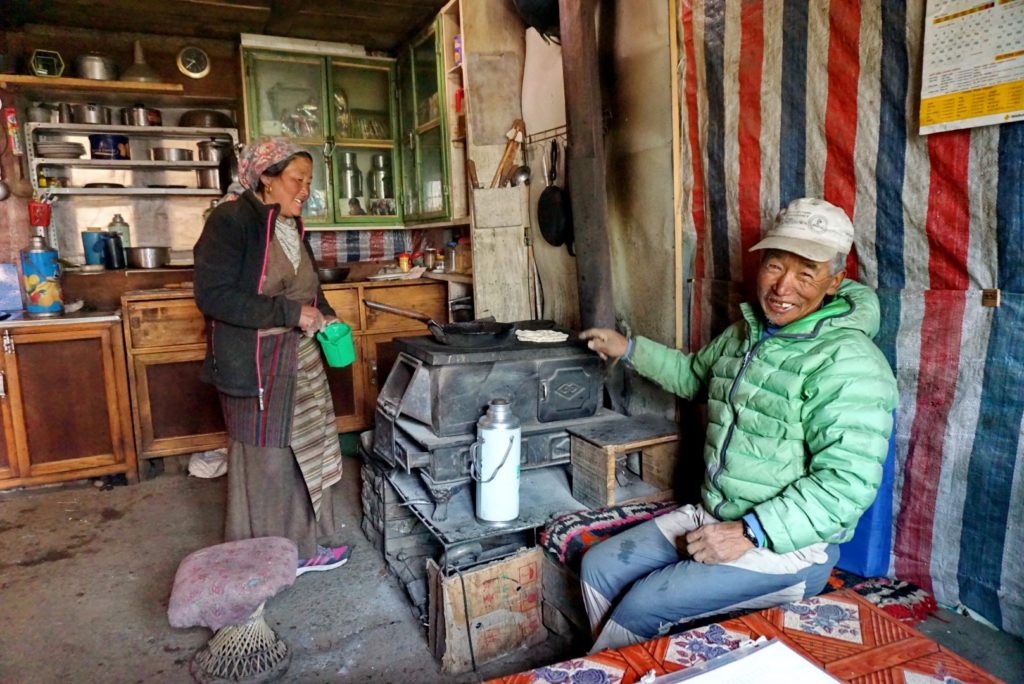
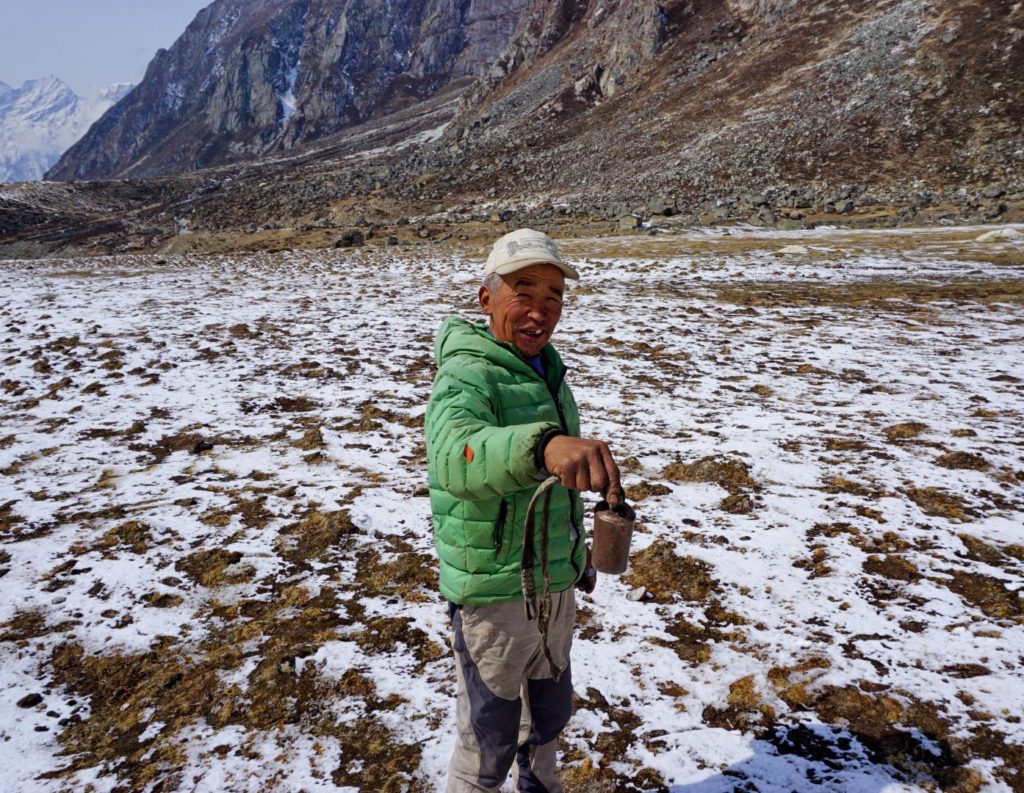
This might have been a sad, forlorn place. The bleak aspect, icy wind, thin soil, children long gone, ruined trade and beleaguered herd. But as night closed in on this tiny light in the wilderness a remarkable thing happened. Dozing beside the fire in the next room, I awoke to the sound of soft singing from the sherpina in the kitchen, something between a Tibetan Buddhist chant and a lullaby. Then I heard her and Pemba speaking quietly in tones both husky and whimsical, followed by laughter and more singing. Their resilience and good cheer in such dismal circumstances was heartening. A last lonely bastion of homeliness at the end of the world.
Next morning the sherpina was gone, away to Namche to stay for a few days with her sister – a strenuous full day’s walk for anyone, let alone an arthritic woman in her sixties. Pemba made my breakfast and waved me off on my day hike up the Lumsumna glacier to a nameless 5000m high-spot on my map – more active acclimatisation. Once through the moraine I slogged up steep slopes of grass, shale and finally screes of frost-shattered boulders. My lungs rasped in the cold air and the blood thundered in my ears. Occasionally the low cloud parted enough to give a view over the glacier into the distant reaches of the valley to the Tibetan frontier, where Western climbers filmed Chinese soldiers shooting unarmed civilians trying to cross in 2006. This was a barren, unforgiving environment. Rock, ice, wind and water; utterly elemental, mineral in nature, but for an occasional bird alighting on a rock. I inched my way up the hillside in thirty second advances, taking another half minute to recover my breath after each effort. Standing on the rime-iced summit block I wondered how long it had been since anyone else stood there, if ever. There were no prayer flags or any of the usual summit paraphernalia. Back at the homestead I found Pemba agitated because of my late return – as usual I had left a little later than planned and gone a little further. I shook his calloused leather hand, strong as a bear, and left him with his yaks, feeling lonely on his behalf.
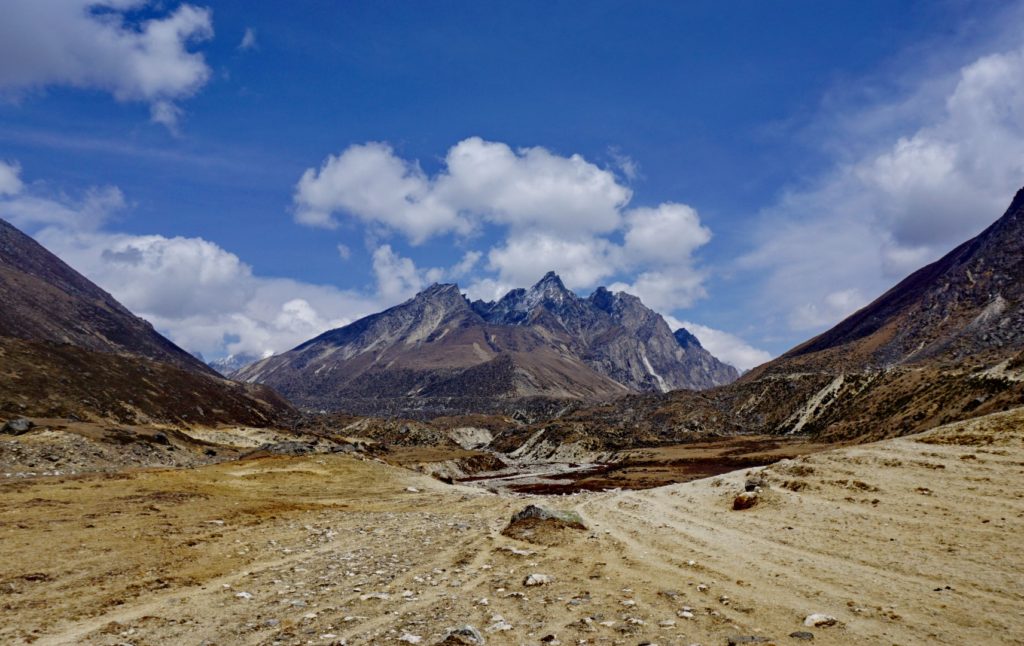
Forty minutes fast walk away, the Renjo La Support Lodge in Lumde was another world. An international crowd of trekkers and their guides and porters talked loudly over each other in the bustling dining room, and left the door open to the wind and snow every time they went out. I had so far largely avoided this commercial side of Himalayan trekking. Now back on the main drag, the closer I got to Everest the busier it was going to get. Eavesdropping, I ascertained that only two parties would be going up the pass in the morning: a group of serious looking French and a tall Swiss woman, both fully supported with guides and porters. I took my time in the morning, letting everyone else rush around and clear out of the way, confident that I would pass them before lunch anyway. In any case, an early or a tardy departure was immaterial since the cloud had been down for two days and showed no signs of shifting.
The view from Renjo La is reputedly jaw-dropping, but it was obviously not going to happen that day; visibility was down to less than a hundred metres. Thick, low cloud billowed and drifted about me, conjuring phantoms that dissolved before my eyes. I put my headphones on and set my music player to random. As I moved through this monochrome mountain-scape listening to Tubular Bells, I had one of the most mesmerising experiences of my life, both synesthetic and kinaesthetic. Seriously. The ‘Piltdown Man’ part in the second movement where Mike Oldfield grunts guttural incantations and howls at the moon transported me into an altered, atavistic state where I became a Yeti. Snowflakes whirled in eddies around me and I felt at one with the world. Aware only of the breath in my body, the weight of my pack on my shoulders, my feet instinctively planting firmly on the uneven surface, I bellowed my best yeti wail. Twenty minutes later I passed the startled looking Swiss and French parties and went ahead breaking trail through the snow up to the pass.
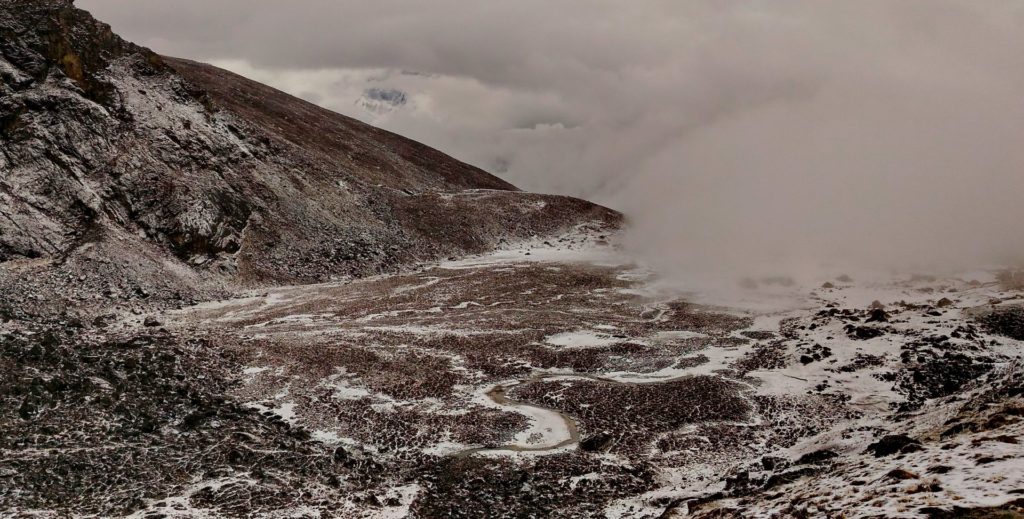
Far below Renjo La the village of Gokyo huddles on the northern shore of its namesake lake, a tiny, fragile human presence amidst active geological giants. Behind it the enormous grey mass of the Ngozumpa Glacier snakes away for forty miles to foot of Cho Oyu, the world’s sixth highest mountain. Collapsing into a homely looking lodge, I was delighted to discover that Norwegian Phillip already installed there, along with three Romanians I had met a few times on the trail and whom I had urged to detour from their EBC-and-back trek to see Gokyo. From the vantage point of Gokyo Ri, a lung-busting, two-hour climb straight up from the village, views of Everest, Lhotse, Makalu, Cho Oyu and Ama Dablam are unsurpassed on a clear day. Gambling on a few clear days, next morning I declined the Ri in favour of a more ambitious side-trip up the glacier to Ngozumpa Tse, a 5500m peak beyond the fifth lake. All went well until the final push for the summit, when the altitude headache that I had successfully shaken overnight returned with a vengeance, hitting me like an iron bar across the base of the skull. A strenuous scramble over precariously balanced, sofa-sized blocks of granite left me rinsed of energy, almost giddy with a feeling of unreality as I gazed down to the tattered ribbon of ice far below.
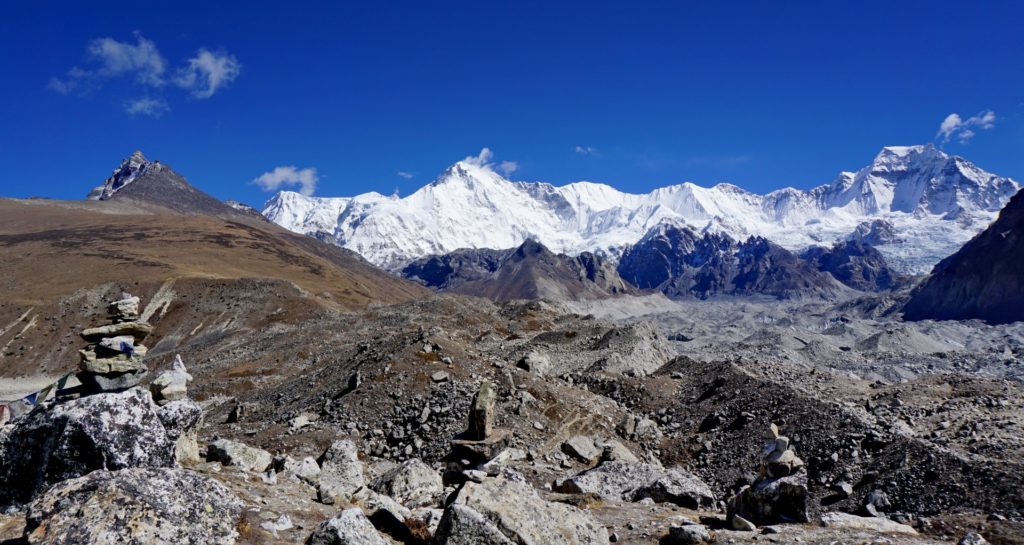
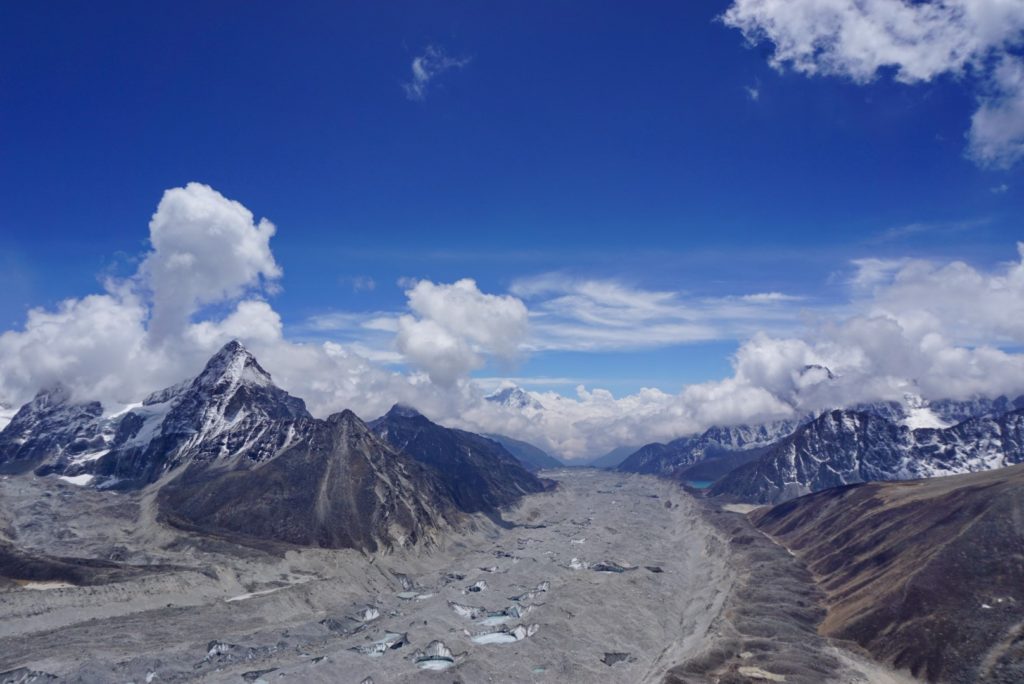
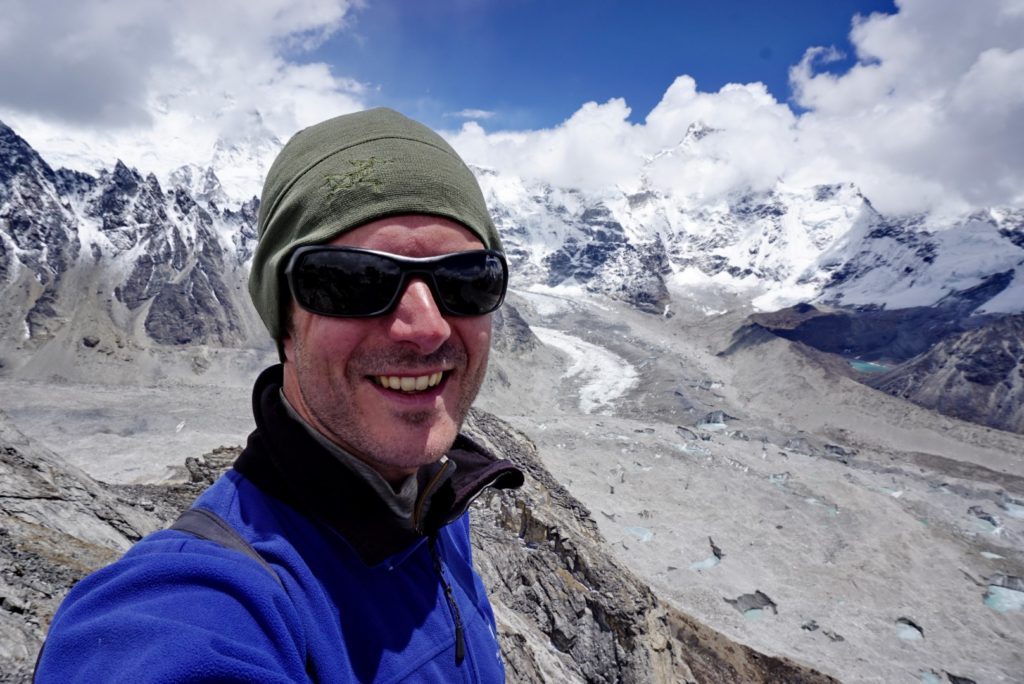
Clouds were massing around the peaks across the valley. That should mean something, shouldn’t it? Vaguely rings a bell. I chewed meditatively on handfuls of raisins and chocolate. Glucose entered my bloodstream, synapses fired and the penny finally dropped. Heavy weather was imminent. Teeter-tottering around up here, beyond assistance even if it could be summoned, was not a good idea. I descended to the moraine as rapidly as I was able, reaching a safe height just in time for the roaring wind to close the clouds about me and blast snow and hail in my face for the 10km slog back to the village. Almost broken by the exertion and the altitude, I ordered hot food and drinks and conked out in the corner. The Romanians showed me their video footage from the summit of Gokyo Ri that morning, beautiful snow-capped peaks against an azure sky, primary-coloured prayer flags snapping on the breeze. I went early to bed, fingers crossed for similar conditions next morning. But try as I might a pre-6am departure eluded me and by the time I topped out on the Ri it was plain to everyone but me that it was not happening that day. Refusing to give up so easily, I wrapped up, sat on a rock and waited, gnome-like. Clouds billowed. Time passed. The Himalaya grew a little higher. My hair grew a little longer. I’d still be there now but acceptance eventually won out (which is to say my bum was getting cold).
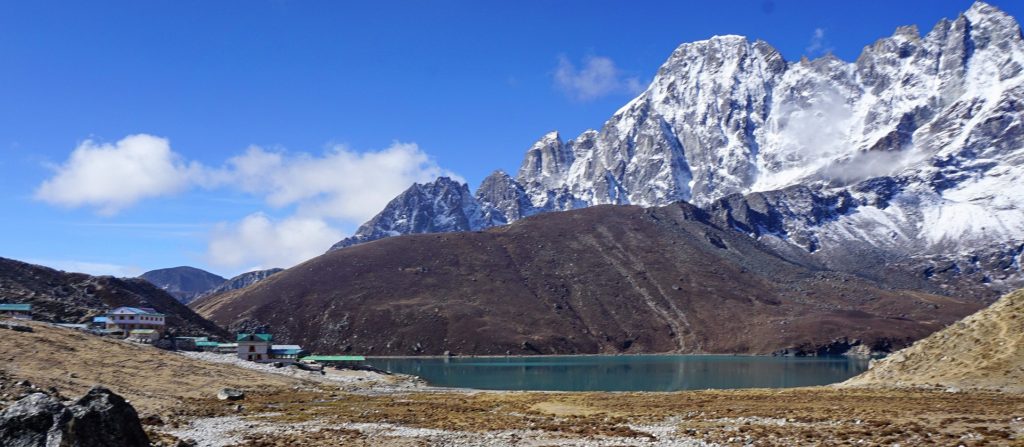
Next morning my alarm woke me at 4am, but out of the window low cloud still obscured everything. This was a known risk of leaving it so late into the season to come up here. I hit snooze for another hour in bed before staggering down for breakfast. Tenzing, the friendly young manager of the lodge, asked what I was still doing here. I gestured out the window at the dismal view. Get going he said, this really was just low cloud, the top of the Ri was high enough to see over it. I flew out the door and climbed in leaps and bounds. As promised, around 200m from the top I shrugged off the damp, heavy blanket of cloud and moved into the quick, light air above; the horizon crystal sharp and piercingly blue. Plump cloud filled the valley below, covering the glacier like an eider down. Above, the great peaks of the Himalaya towered like apparitions. Pyramids of light, jewel-like and brilliant in their beauty; fang-like and terrible in their blank indifference.


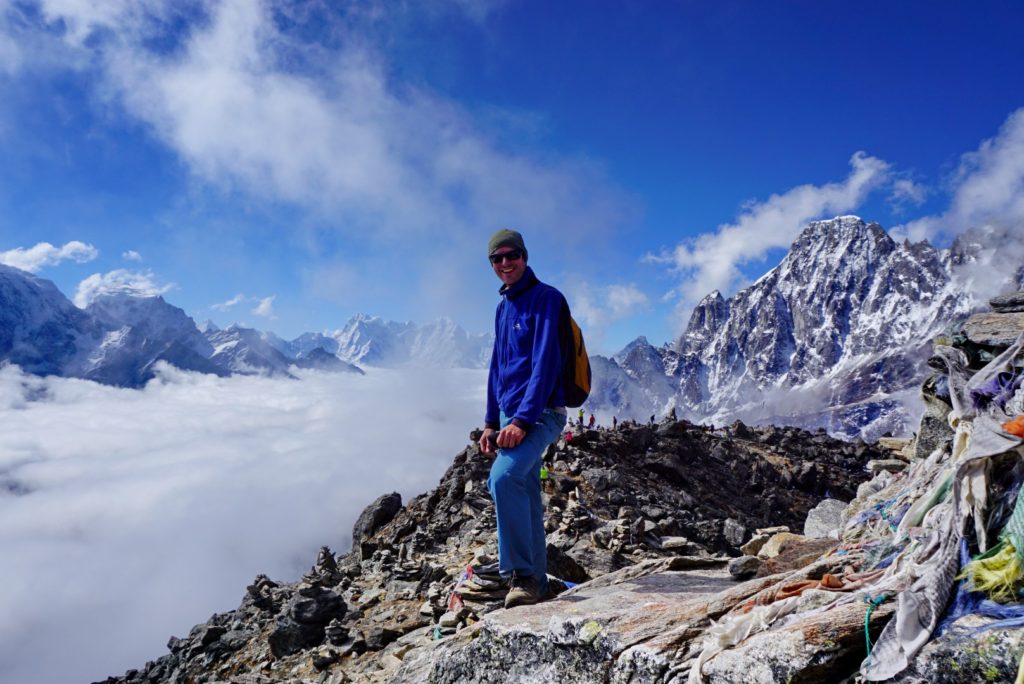
My head reeled with the immensity of the view. I found a quite spot to contemplate… this moment, this scene, this photic agitation of the rods and cones in my retinas … was this was why I had come here? Yes, in part. Unmediated by description and witnessed quietly it was one of the most satisfying moments of my life. But, aside from the considerable effort to get myself to this place, it was an essentially passive experience, non-participatory you might say. I was under no illusions about actually climbing the peaks I was looking at, but I was ready for more physical interaction with this landscape.
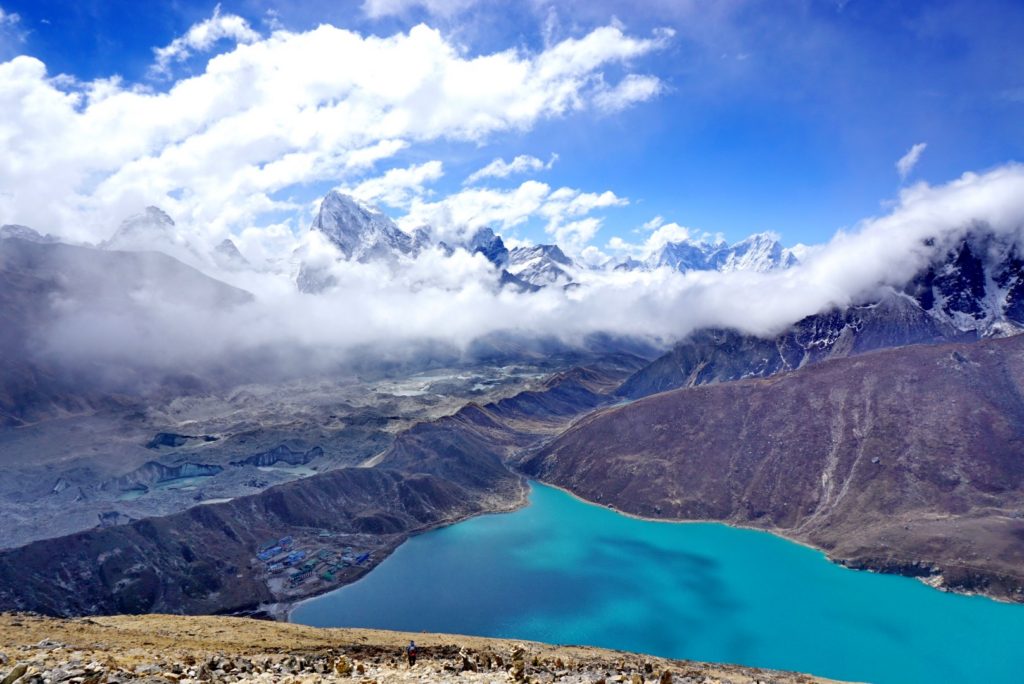
I left behind the relative comfort of Gokyo, crossing the Ngozumpa Glacier on the way to the tiny hamlet of Dragnag at the foot of Cho La, ostensibly the most formidable of the three passes. After a glacially cold bucket shower and laundry I found I was not alone in this otherwise silent lodge. Joan, an elfin Australian-Chinese woman, whom I had briefly met during my semi-comatose supper in Gokyo two nights before, joined me by the fire. Tentatively she asked whether I’d had to jump across any of the meltwater streams that run through the glacier. I had not. Somewhere amongst the chaos of boulders and ice hills on the glacier, Joan had lost the thread of the path. Alone and off route, she had dared a leap across one of the streams, but fell in! Luckily she was able to swim to a gravel bar on which to haul herself and her pack out of the frigid death-trap. After a day and night defrosting, drying out and reflecting on her narrow escape, her confidence for solo trekking was understandably a bit dented, so we agreed to team up for the climb over Cho La in the morning.
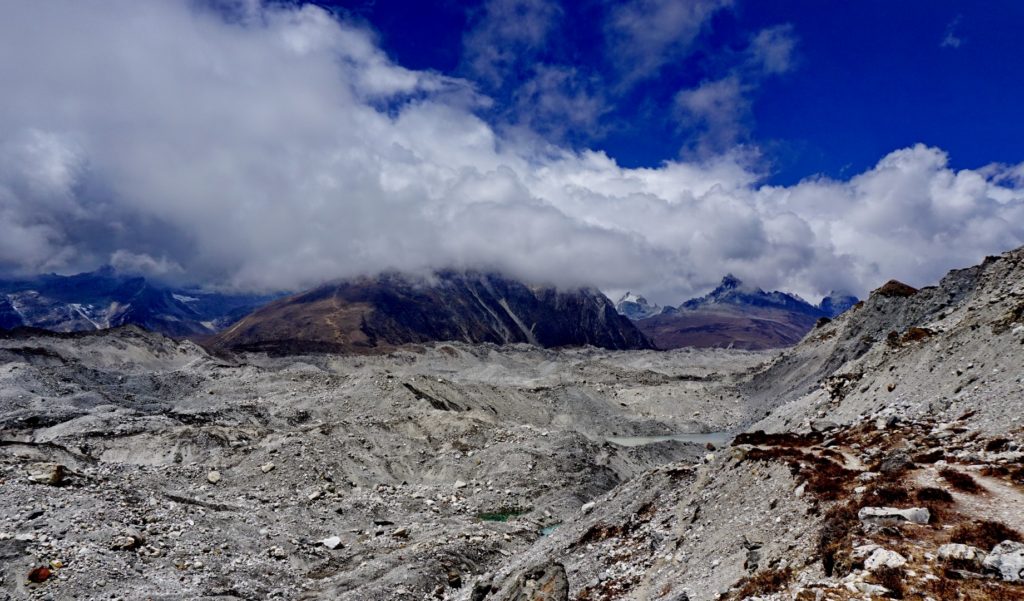
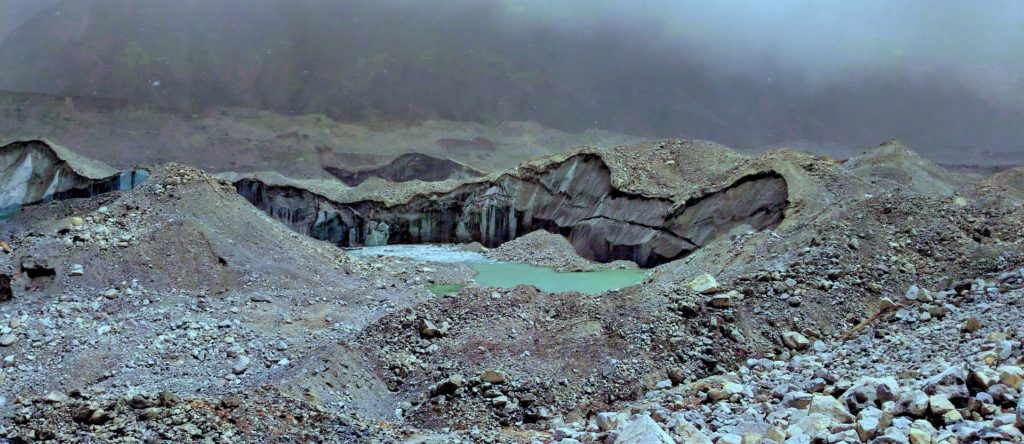
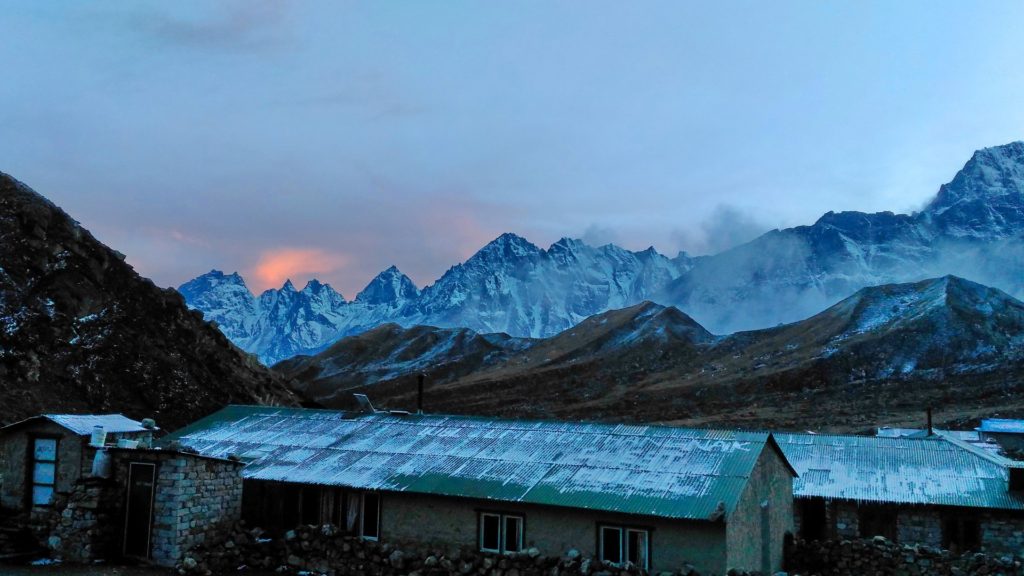
Arriving at the foot of the pass itself, a steep wall of snow and icy rock towered 200m above us. Early starters from the other two lodges in Dragnag were already tracing a path of zig-zag steps through the otherwise impassable terrain. My usual approach to ascents tends towards ‘bull at a fence’, but Joan was not keen on maxing out heart and lungs in one continuous push to get past all the unfit and ill-equipped guided parties. Taking it steady, stopping to catch our breath frequently, we still passed almost everyone on the slope. On the way past we donated some of our limited drinking water to a diabetic hiker who had bafflingly let his guide carry his water, from whom he had become separated. I later found said guide loafing on a rock smoking a cigarette, looking bored.

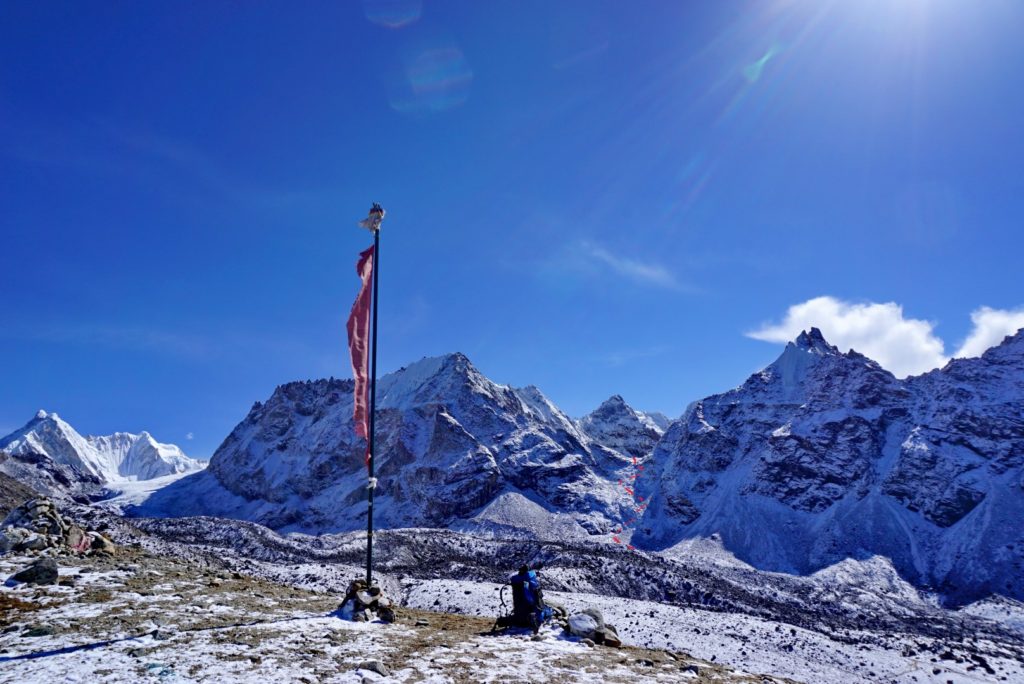
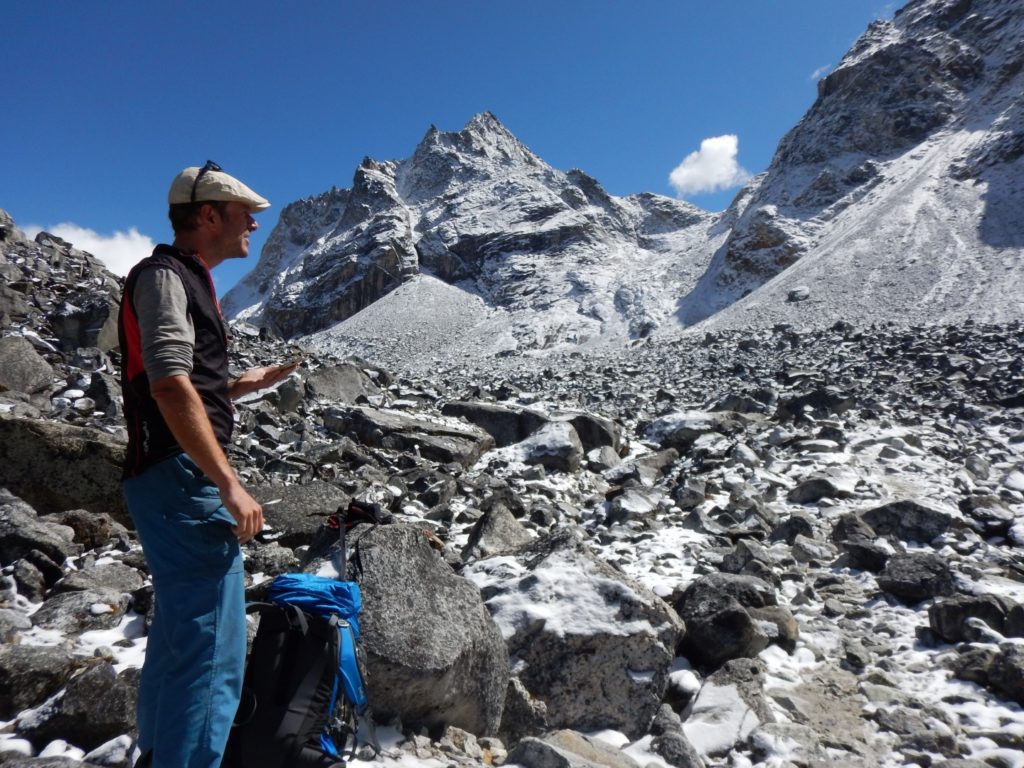
Over the pass, while Joan descended a steep icy gully onto safer ground behind me, I sat on a ledge beside two Nepali porters and looked on (we made these dodgy traverses and descents separately to avoid taking out the other if we slipped). I observed the mountain-hardened faces of the porters register total astonishment as they watched Joan scamper down off the glacier, her rucksack almost as big as her own tiny frame, sure-footedly floating over rough ground that reduced most other trekkers to an awkward lurching hobble. Any initial scepticism about how well-matched we would be as trailmates was replaced now with something more like pride by association.
Arriving at a lodge in Dzonghla at noon, the all too familiar ache in the brainstem had returned. The weather had turned; a bitter wind scoured the already bleak valley with snow and hail, so I was as grateful as ever for a corner of the quiet communal dining room to pass out in. After half an hour I was roused from semi-consciousness by Led Zepplin’s Immigrant Song turned up loud (as it should always be) on the lodge’s stereo system. Retired Everest multiple summiteer turned lodge owner, our Sherpa host was a massive Lep Zep fan and treated us to another two hours of the good stuff as the lodge filled almost to bursting, seats by the stove becoming ever harder to hold onto. In the morning I still felt like death warmed over, so I was glad that Joan agreed to continue trekking together to Everest Base Camp and the viewpoint of Kala Patar.
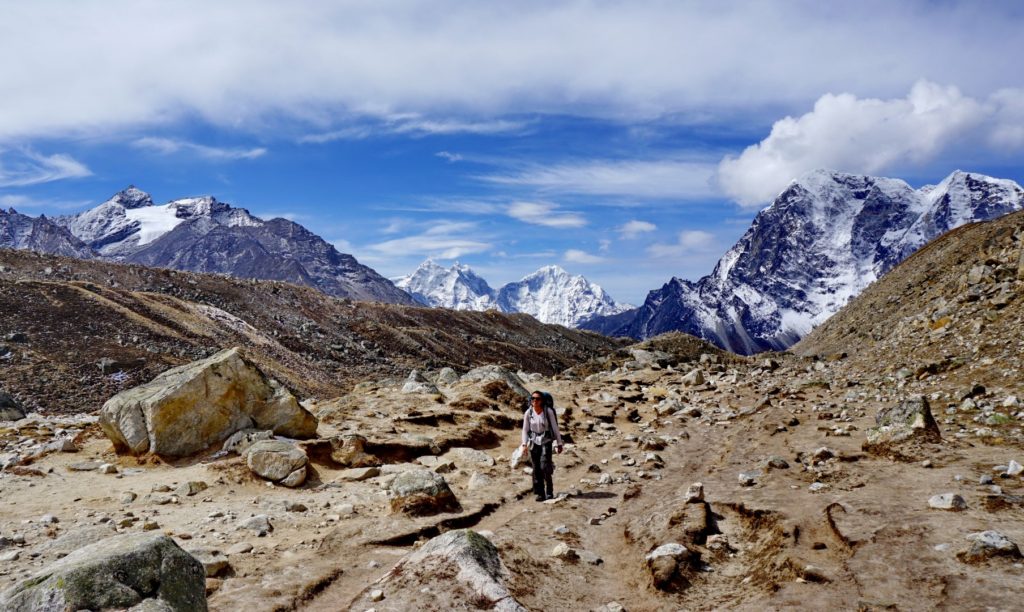
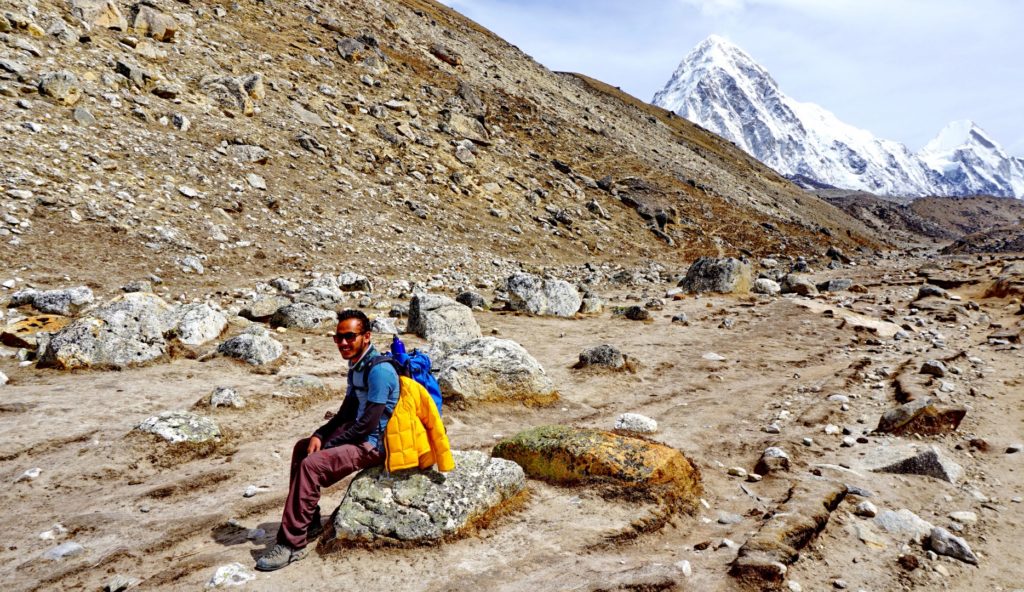

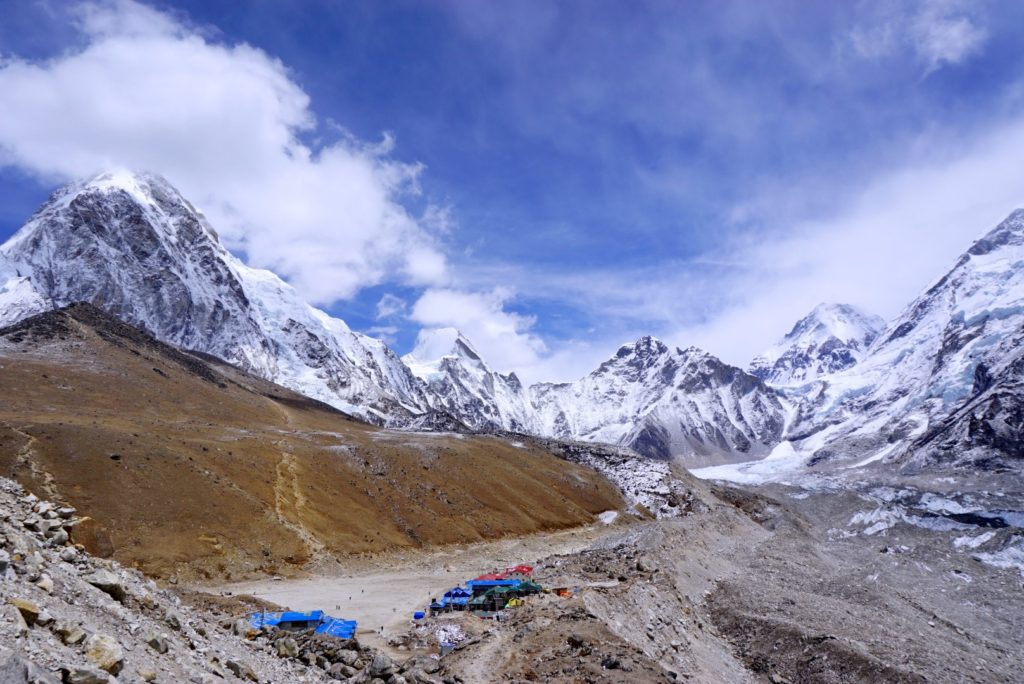
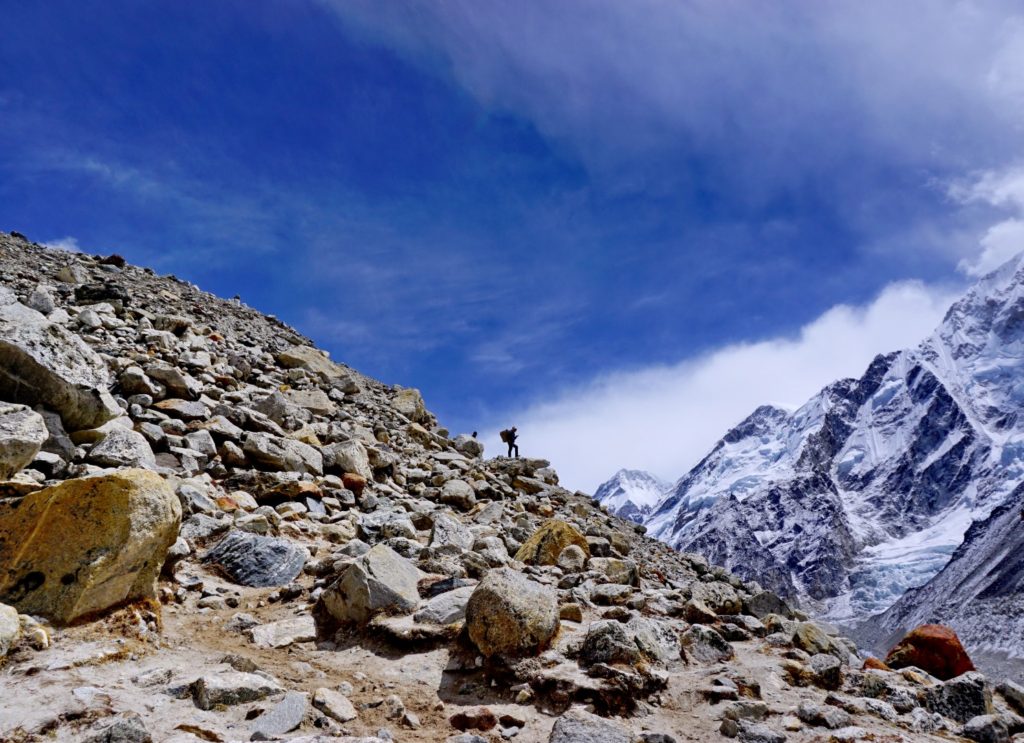
We arrived in Base Camp late in the afternoon after most of the day visitors had already descended. We wandered freely amongst the tents perched on patches of dirty snow scattered across the top of the Khumbu Glacier. The place was eerily quiet, save a few people tinkering with stoves inside mess tents and the gurgle of meltwater streams disappearing into the ice. I chatted with Rob, an American climber with the ‘Altitude Junkies’ outfit, out stretching his legs while he waited along with everyone else in camp for a summiting date. Expeditions are now centrally co-ordinated to avoid disasters like that on 10th May 1996, when a bottleneck at the Hillary Step led climbers to flout their predetermined turnaround times. Eight people died on the upper slopes of the mountain that day. Exactly twenty years later to the day, there was a somber, tense atmosphere in camp. No one had summited for almost three years – the 2014 season was cancelled after a massive avalanche on the Khumbu Icefall killed sixteen Sherpas; in 2015 the devastating earthquake put the mountain off limits. Rob was sanguine about his chances, despite having made two previous attempts as a paying client of professionally guided outfits. His rattly Khumbu cough (a common side effect of prolonged periods at altitude) gave him no cause for concern. He would have gladly shown me round, but his outfit had a no-visit policy, meaning that no one outside the expedition team comes in and expedition members may not visit any other outfits at Base Camp. This was not to protect trade secrets or plans, rather to minimise exposure to viruses and other imported infections from newly arrived climbers during these critical pre-summit days, when immune systems are already weakened from weeks at altitude.
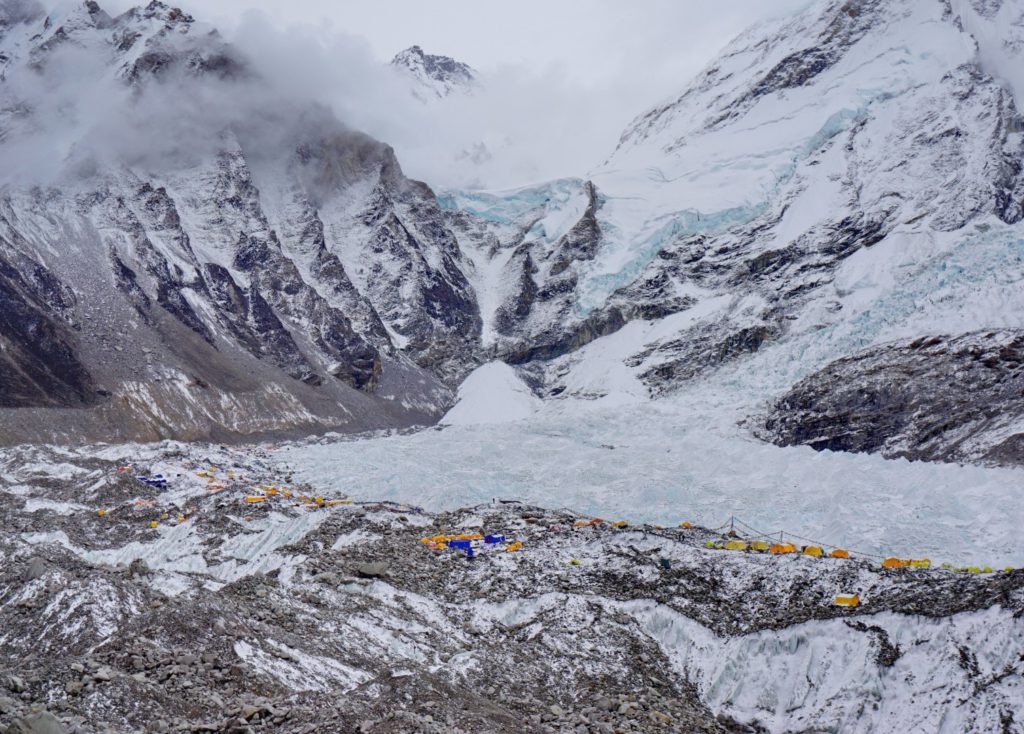
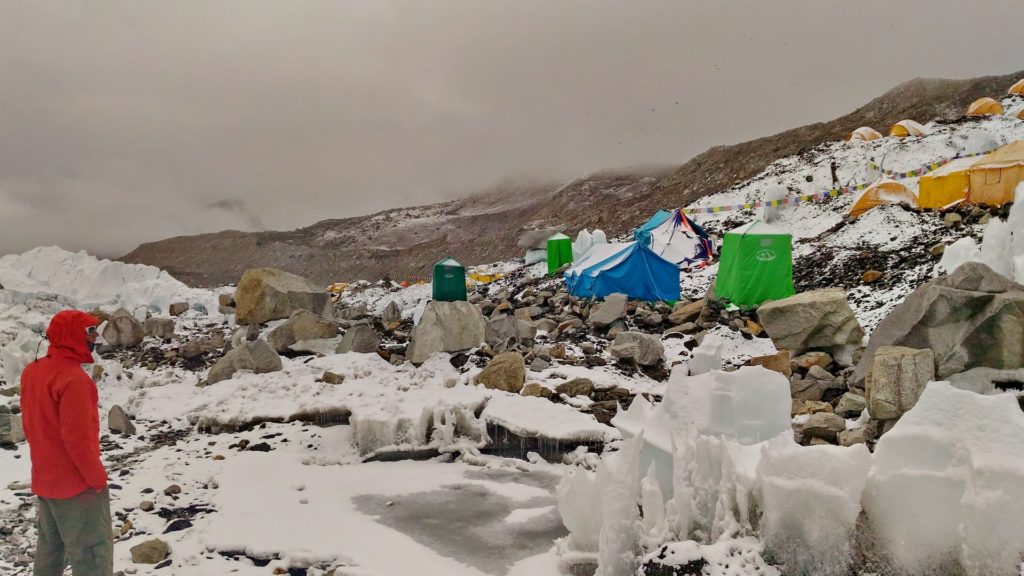

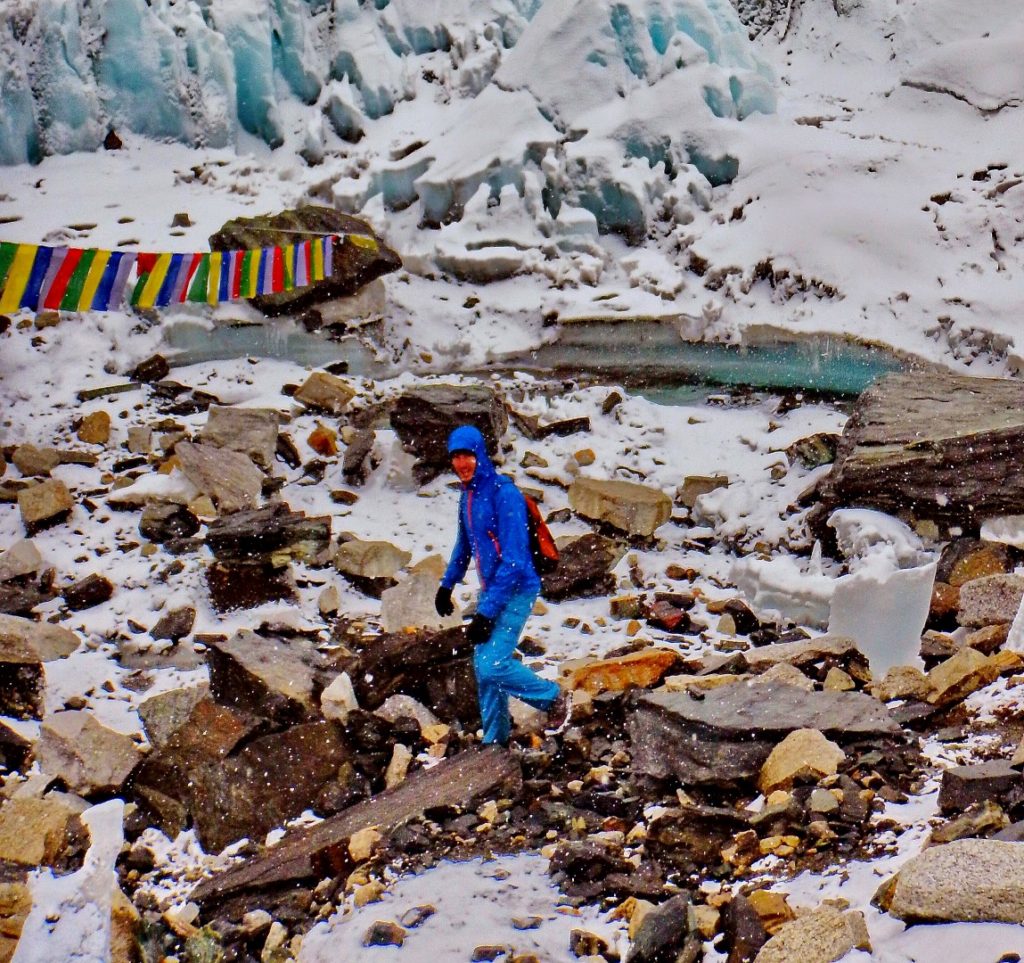
Wandering ruminatively back through the mist and slush of Base Camp I bumped into Joan who had had her own local encounter, sitting in a warm tent drinking cocoa with the camp’s official ‘artist in residence’. That night, spent in Gorak Shep, stands out in my memory as one of the most unpleasant of my life. Retiring early with a headache to my 2m by 3m plywood cell, I rammed in my earplugs, necked a couple of ibuprofen and hoped for the best. The hours passed with agonising slowness, during which I had the terrifying breathless sensation of being buried alive, along with repeated auditory hallucinations. At breakfast Joan pressed me to take Diamox (to alleviate minor symptoms of altitude), something I had held out against, preferring to know if I was succumbing to AMS (acute mountain sickness) from ascending too quickly. In no condition to argue when Joan adopts nurse-mode, I popped the pills and sheepishly joined the death march up to the viewpoint on Kala Patar. At 5640m (18,519 feet), this is the best view of the summit of Sagarmatha (Mt Everest) non-climbers will ever get. I could hardly have been less interested. I vaguely pointed the camera and clicked vacantly, thinking only of getting down from this airless, enervating environment, feeling that I was dying with every minute spent there.
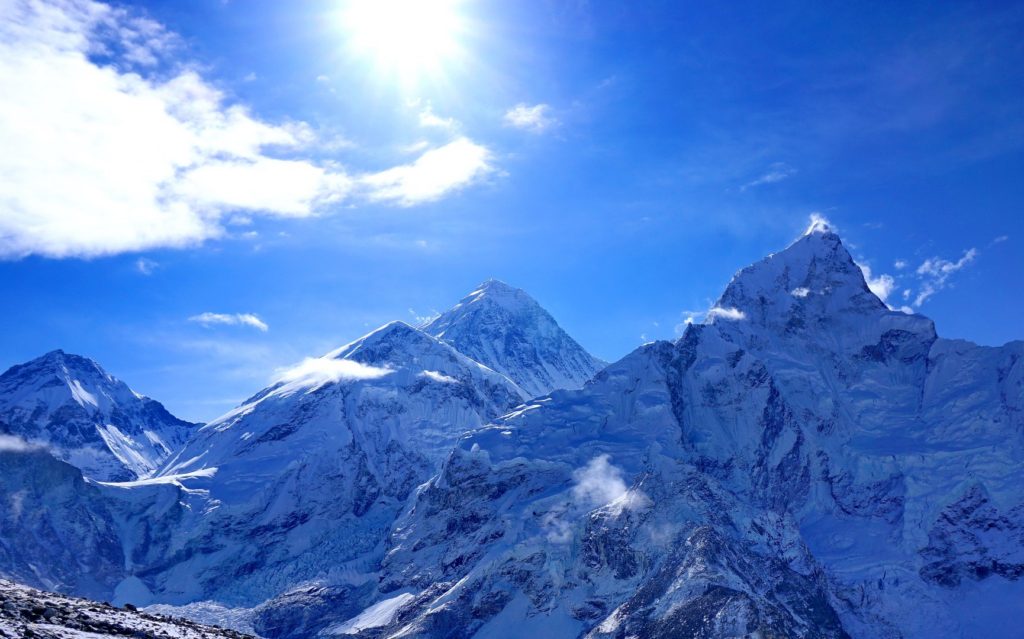
Joan and I parted company in the notoriously grubby waystation of Lobuche, from where I gingerly plodded over Kongma La, this time in the company of a guided German trekker and solo Italian. Amiable banter made for a leisurely ascent and I finally got to experience a 5000m+ pass without the awful brain-pain. I had intended to spend a couple of days exploring the hills around Chukkhung, perhaps even tagging a sneaky 5850m peak (you are supposed to have a climbing permit for any peak over 5800m). In the event, I just couldn’t be bothered. I’d been pushing my luck with the weather and the altitude for a couple of weeks now. It was time to move on and think about the long walk out. After the frugality of the last two weeks, Namche Bazaar exerted a strange homelike pull and for the second time kept me hanging on for longer than planned, in part due to welcome reunions with Joan, Phillip, Canadian Brigitte, Romanians Marius and Carmen, mischievous Shepina Chiring at Namaste Lodge, and several other familiar faces from the previous month.
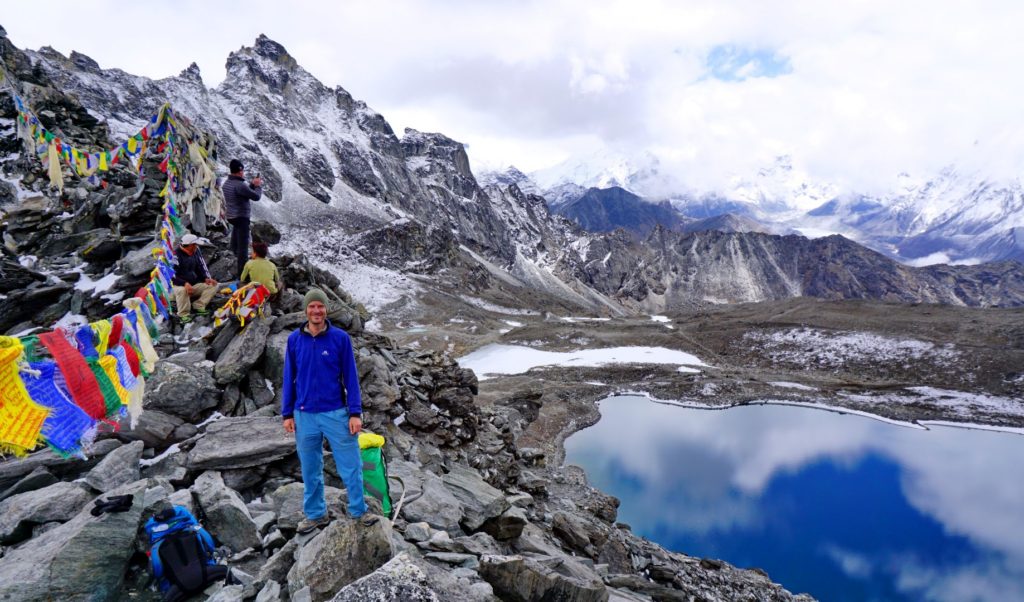
Descending out of the rarefied, sterile atmosphere of the high mountains into the verdant, vital Dudh Kosi valley, the air felt opulently thick with oxygen, supercharging my legs and giving a feeling of mild euphoria. Despite the hardships of fatigue and altitude, I had relished the peacefulness and contemplative cadence of traveling on foot. Now that the physical discomfort was over, I was suffused with well-being and optimism – a fug of smugness that lasted almost a whole forty-eight hours. Right up until I was poisoned.
Halfway through my customary breakfast at a remote lodge in Pangom my innards were suddenly gripped by a stabbing pain than only increased as time went by. Hoping that it would pass, I fell back in my room and tried to find a position that did not aggravate the agony I was experiencing. After an hour the pain was so acute it made my eyes water. I tried to make myself sick, but nothing would come up even with two fingers down my throat. Half delirious, I quizzed the sherpina on what ingredients she had used for my breakfast. She was predictably defensive but her husband showed me various unlabeled, dirty containers of flour and milk powder substances. By bizarre coincidence, also in the lodge was a delegation of medical doctors from New Zealand and UK, visiting the region for the imminent Everest Day commemorations. One prodded me and asked various diagnostic questions. To my relief he ruled out appendicitis. With a shrug he said something had probably caused my gut to spasm, so just grit your teeth, there’s a good chap. Not wanting to risk another night in this place, I packed up and dragged myself along the lonely trail up the hillside. In two hours I covered less than three kilometres, periodically forced to sit and hug my knees – the only position that seemed to help. Gloomily considering my options, I stood up shakily to ask for a place to stay in one of the nearby shacks. But wait, no pain. I stretched and twisted. A faint ache, but nothing like the searing skewer in my abdomen of the last five hours.
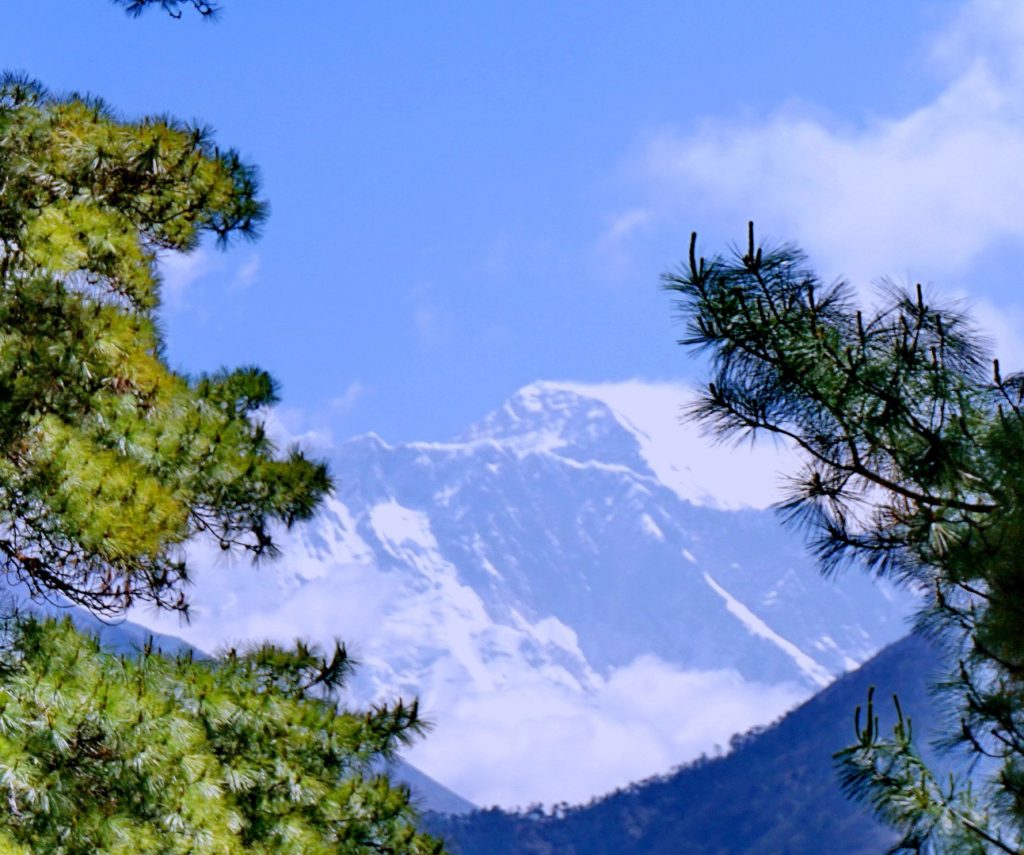
Now suspecting that witchcraft was involved (do they have voodoo in the Khumbu?), I went on my way, just glad to be alive, taking the steep, deep ravine-like valleys in my stride. Out here in the unfashionable eastern foothills of the Himalaya I was once again on my own, more so even than on the walk in from Jiri. In four days I met only three other trekkers (a couple and one solo). The locals treated me with curiosity and simple, honest hospitality. In the amazingly peaceful, rustic lodge at Kiraule I sat by the fire with the lodge owner and drank his homemade raksi, his daughter quietly doing her homework on a rough-hewn trestle table in the corner, chickens wandering in and out of the hut. The relaxed, homely vibe continued through the twin villages of Bung and Gudel, which cling to opposite sides of the precipitous Hinku Khola river gorge. As night descended over Gudel, I sat in the afterglow of a couple of beers listening to the gentle hum of conversation and the noises of a village winding down. I felt a remarkable calm contentedness there. Still several strenuous days walk from the nearest roadhead, this less-travelled side of Himalayan trekking was starting to win me over.
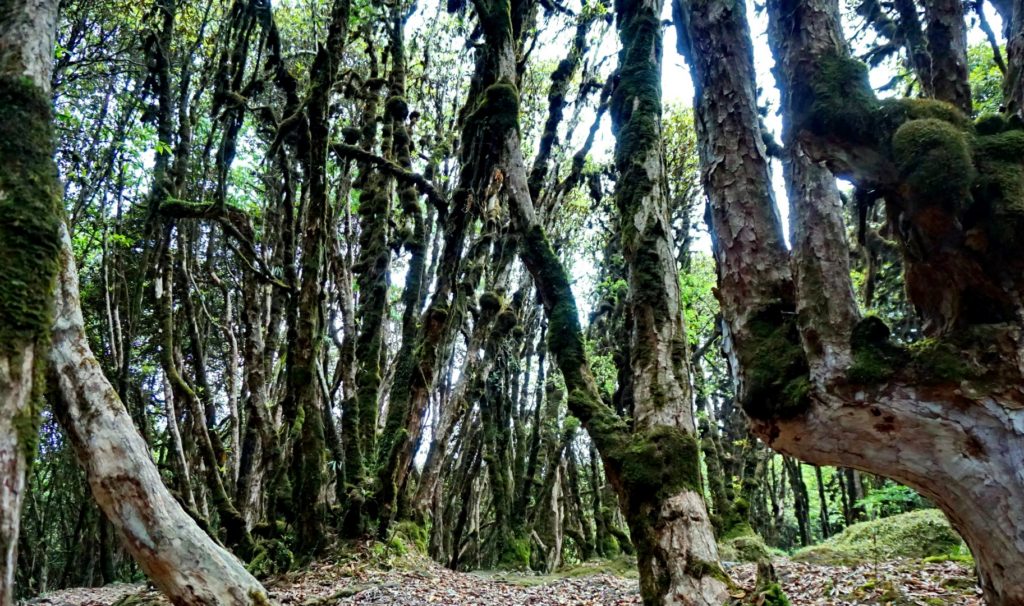
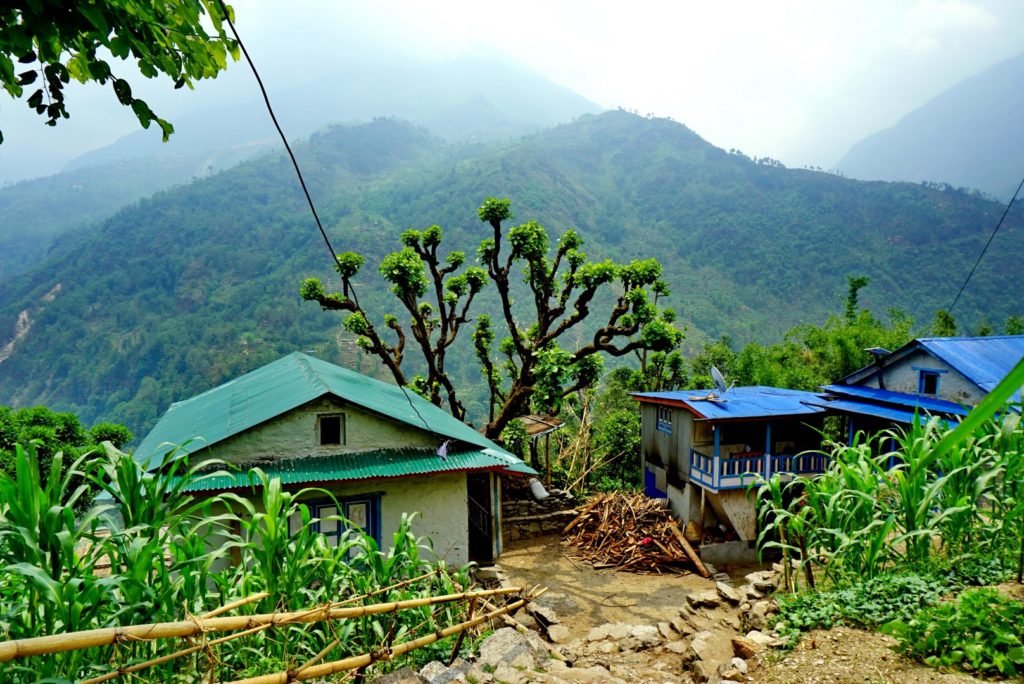
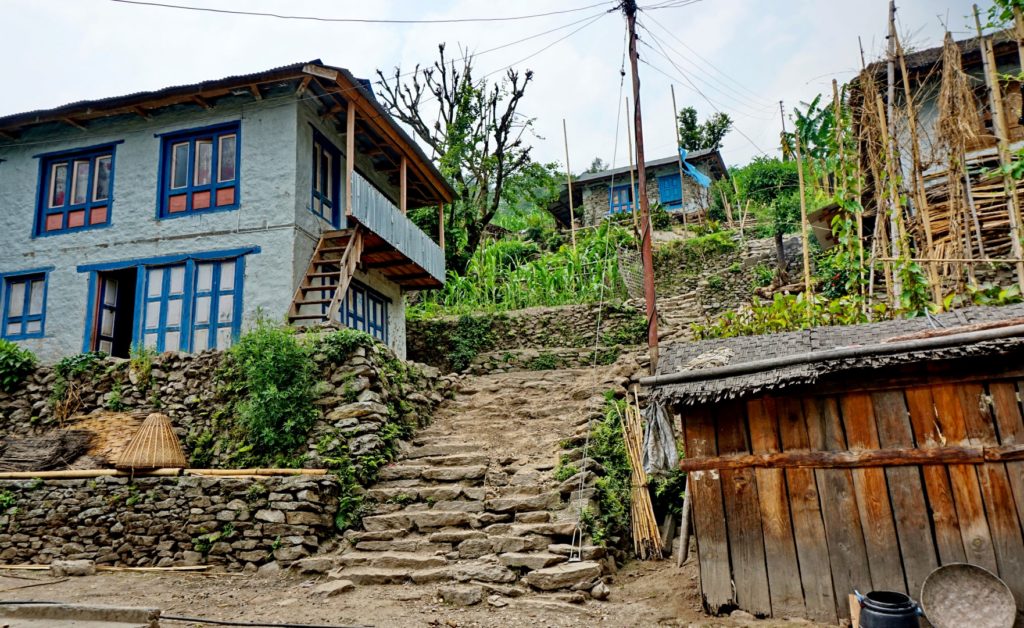
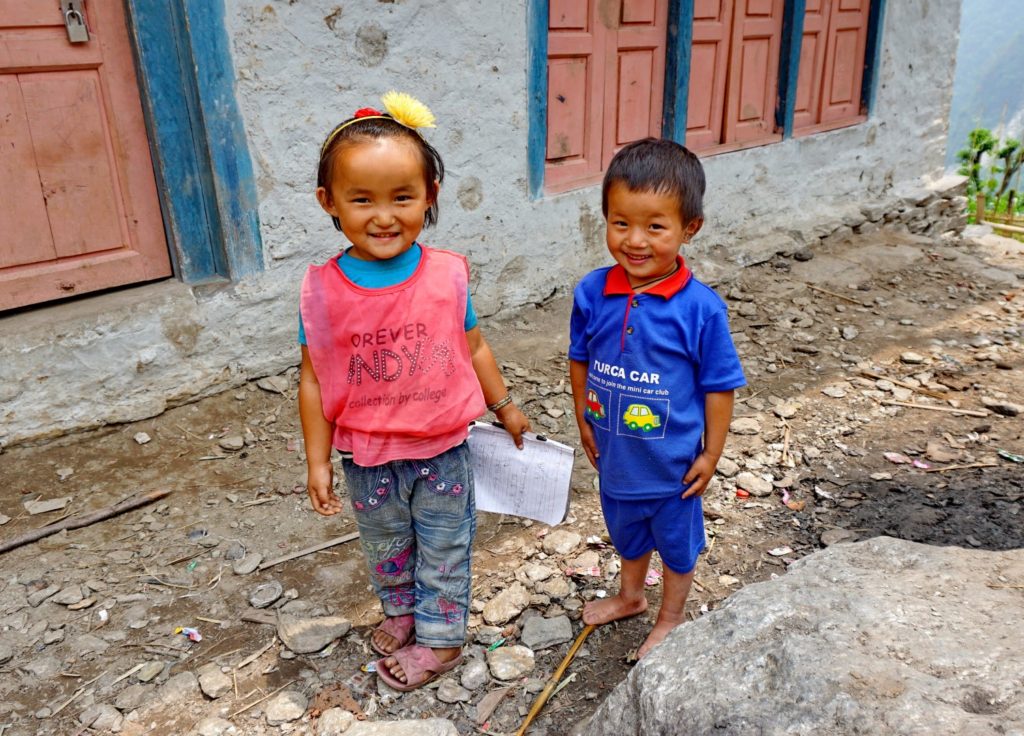
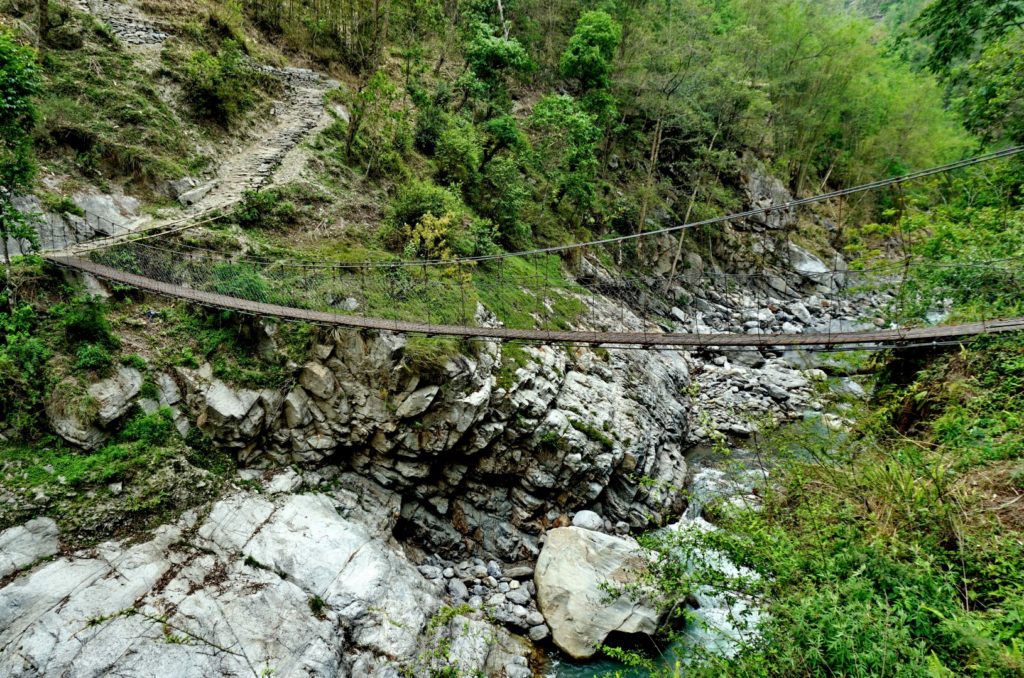
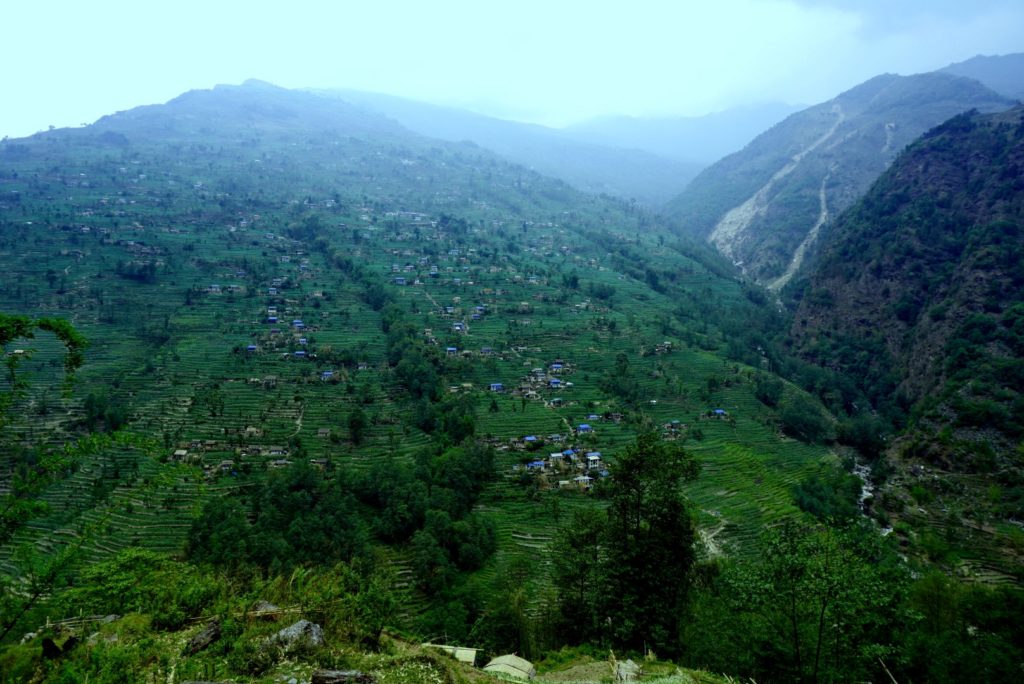
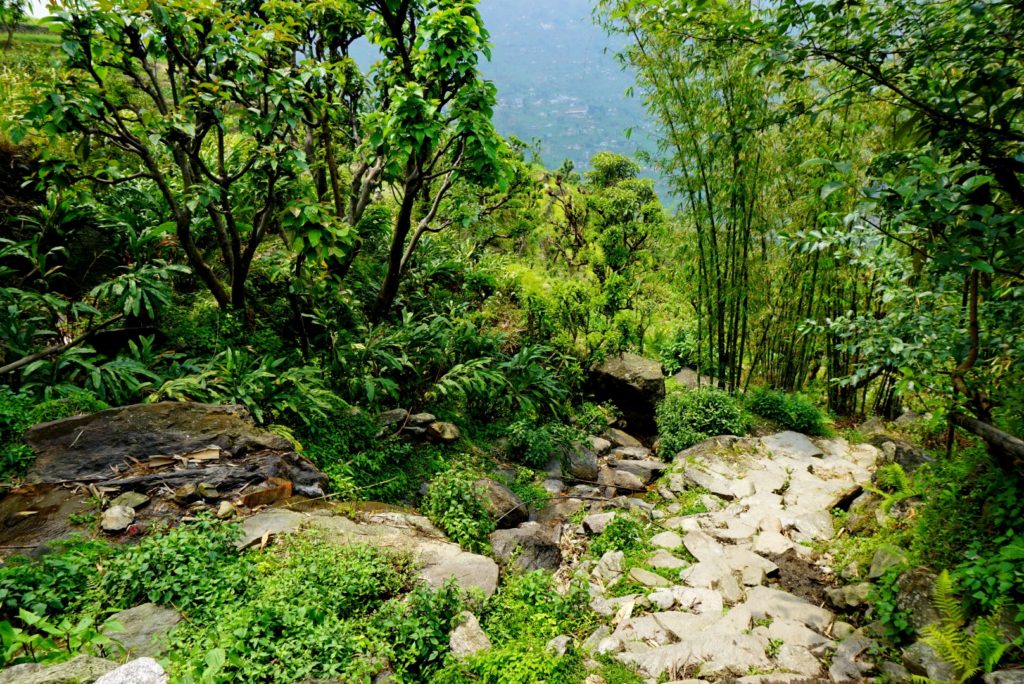
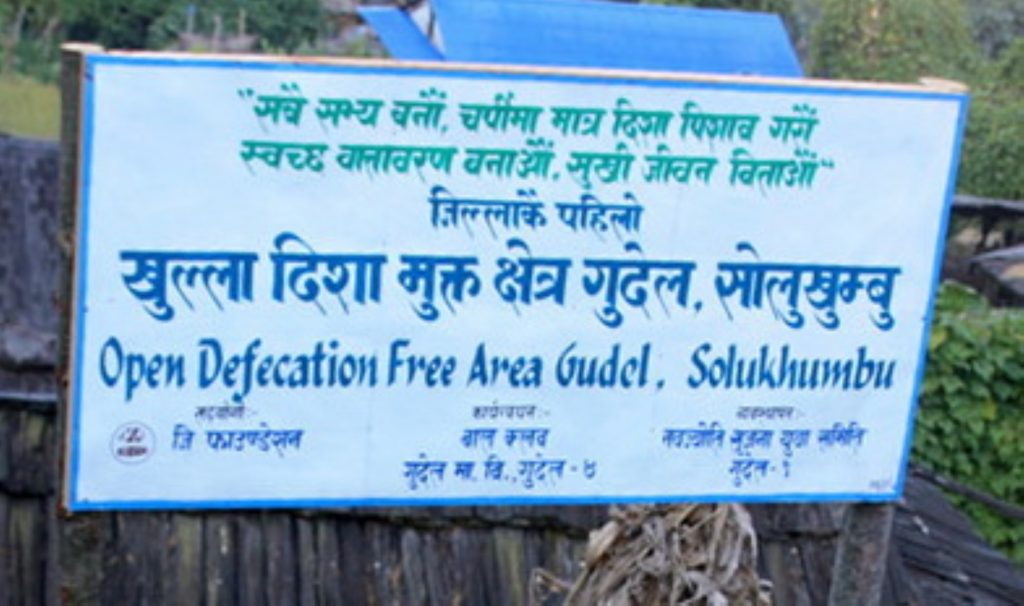
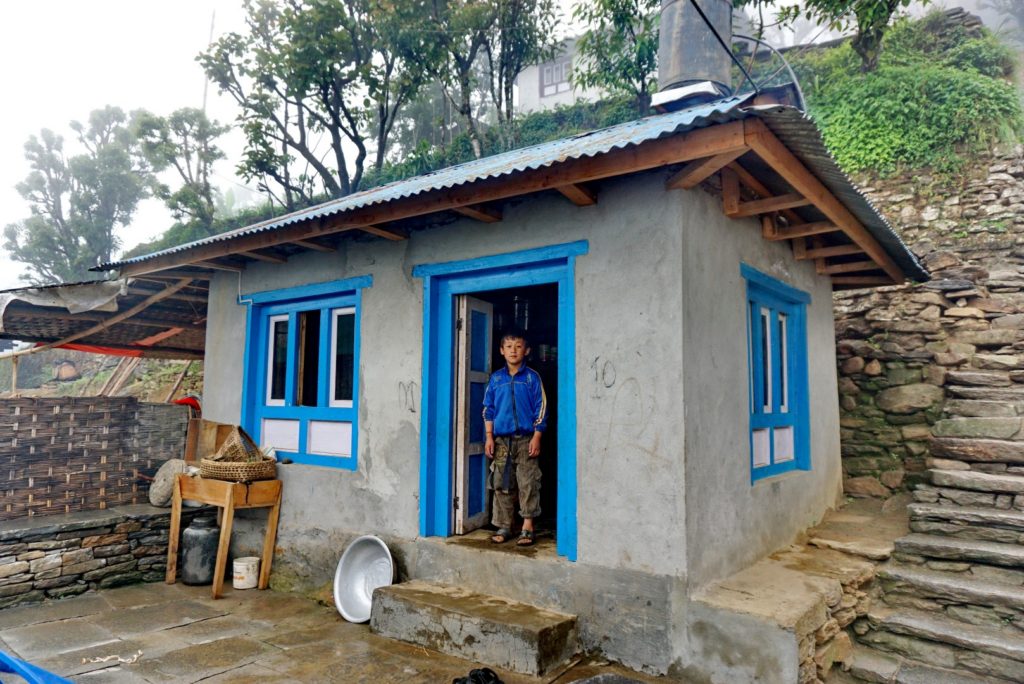
Early next morning, the trail toward the Salpa Pass was busy with Rai villagers on the move. Everyone was heading my way, many carrying sleeping bags and picnics, umbrellas ready to deploy against the on off rain. They giggled good-humoured greetings as we leapfrogged each other on the way up the hillside.
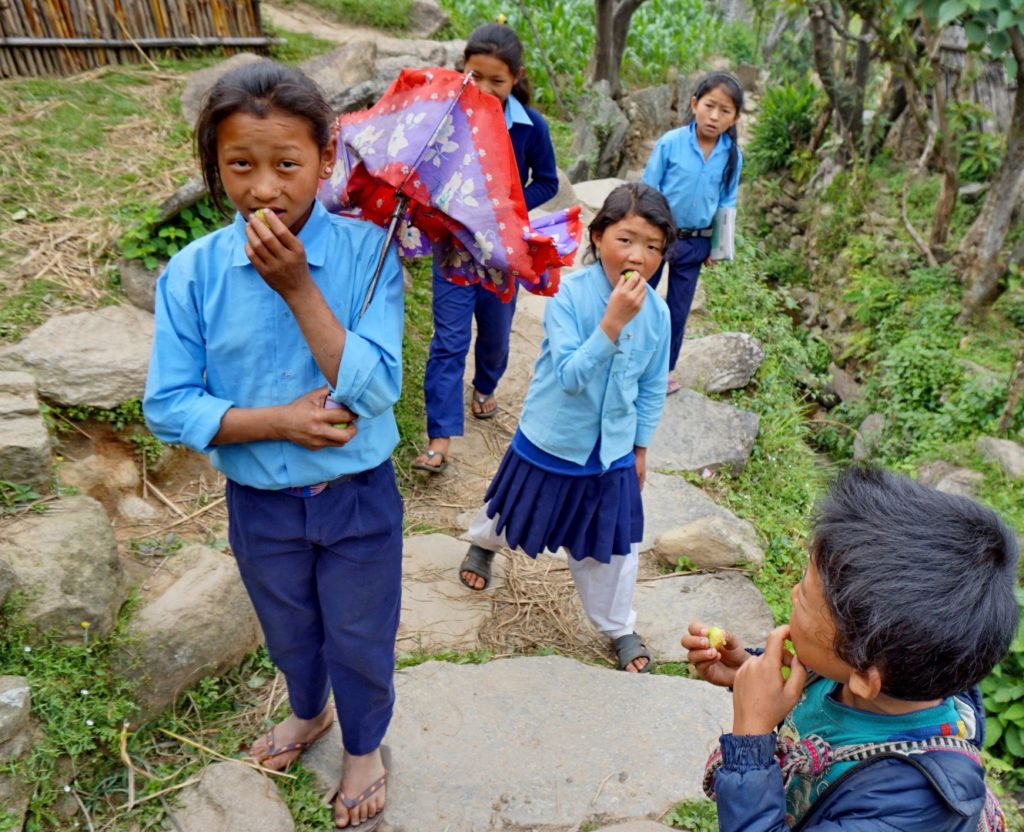
There was a carnival atmosphere as I neared the pass itself. I encountered groups with elaborately costumed elders (the village shamans) and people banging drums and boisterous singing. When groups from different villages met on the path they stopped to perform ritual greetings and songs. Everyone was going to visit the nearby sacred Salpa Lake on this ritually auspicious day. All the way down the long, slippery descent I shared the path with hundreds of Nepali pilgrims, families of all ages.
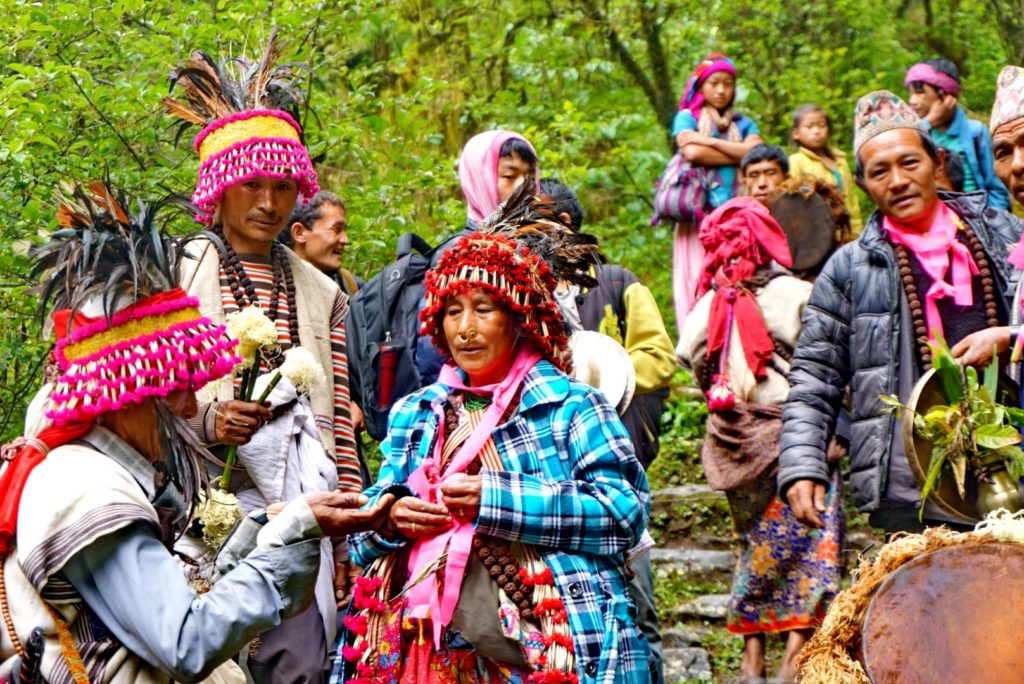
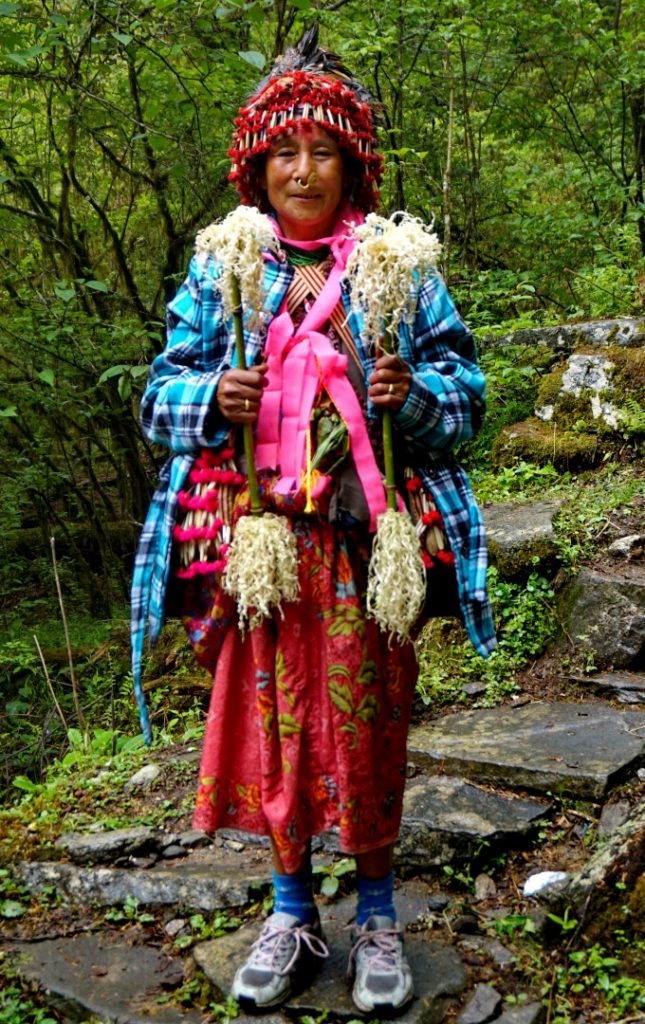
Down and down. The Irkhuwa Khola river valley buzzed with insect and bird life (including my old friend the brainfever bird), enormous monitor lizards darted across the paths, lilac butterflies swarmed in shafts of sunlight. Terraces of corn, millet and barley were interspersed with stands of giant bamboo, surely one of the most versatile raw materials on earth. Lodges out here were little more than shacks on stilts over a byre. Food was the usual plentiful dal bhat; water drawn from a single communal tap outside. Sanitation was primitive to say the least; unusable in fact where I stayed on the way down from Salpa pass.





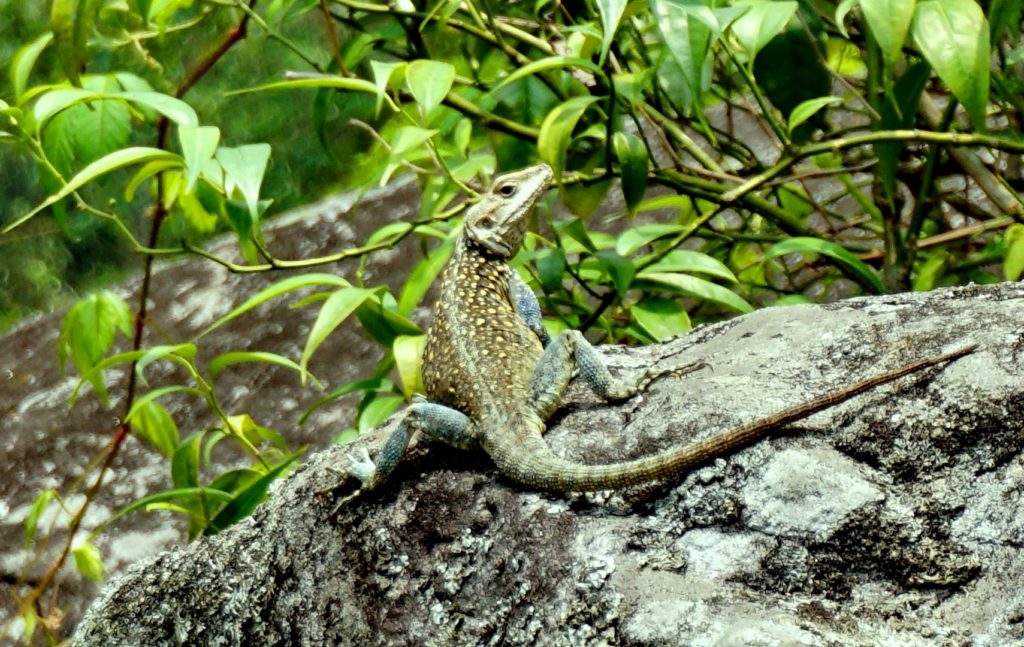
In Dobhane I was attempting to negotiate something non-dal bhat for lunch when a chap who had been watching from the back of the room with a look of wry amusement offered to intercede for me. After I had polished off a bowl of noodles he suggested I should join him at his relative’s house a few miles along the trail for better food. As we walked he introduced himself as Deshraj, on his way back to his birth village high up the valley side, having recently returned from his family home in Kathmandu via a pilgrimage up to Salpa Lake the day before. Deshraj pointed out plants and explained their uses as we encountered them, and was curious what brought me to his homeland. If I was not in a hurry to get back to Kathmandu, he ventured, perhaps I would be interested to visit his village? I didn’t hesitate to accept, especially when the added promise of a shower was thrown in. For almost an hour we climbed steeply through terraces, between bamboos and across gullies on the faintest of paths, until we reached the village of Dangmaya, a loose collection of homesteads scattered on the hillside about 400m above the valley floor. Desh brought me to a bamboo water spout disgorging into a stone basin besides one of the paths near the village, and made it clear that this was the shower he had promised. Water had been such a precious commodity in the high mountains (even a cold bucket shower usually cost $5), so I was well due a bath. No prevaricating, I grabbed my soap, stripped and jumped in. Desh was mortified. As I dried and dressed, he made his own more discreet ablutions, keeping his shorts on. I asked what would have happened if anyone had chanced by while I was washing. They would have run away screaming, he said.
But Desh was as forgiving as he was generous, and over the course of the next three days he introduced me to members of his extended family throughout the village. It was never clear who was actually a blood relation and who a neighbour. People were referred to variously as brother, cousin-brother, uncle-brother. Bonds of kinship were more ambiguous and inclusive here than anywhere I had been before. We stayed first with one of the few outsiders to have married into the village. We slept in a cool raised bamboo hut built by Desh for the family. Desh was effectively the headman of the village, taking the role of informal mayor-cum-landlord to many of the residents. Later we stayed with Desh’s ‘uncle-brother’ and his wife, Rita. People’s days were spent working their crop terraces, repairing irrigation dams, moving oxen, tending to pigs and goats. Hard, dirty work, for sure, but everyone we met emanated a patient satisfaction with whatever task they were engaged in. Laughter was never far away. Evenings were spent cooking and talking around the indoor campfire, the heat controlled by sliding sticks further into or out of the flames. Furniture was minimal, a bed frame or two, a few metal pots, plates and cups, perhaps one or two solar electric lights per house. Their religion was essentially animist – virtually anything might be considered sacred. I was warned against wandering off alone too far into the jungle for danger of being kidnapped by the bon jhakri, or forest shaman. They usually take infants who later return to their communities and grow up unusually gifted. No one could say for sure the danger they posed to wandering Englishmen. To be honest my main hazard seemed to be the constant threat of being married off to a Raini woman, although none was ever presented for my inspection (I did ask).
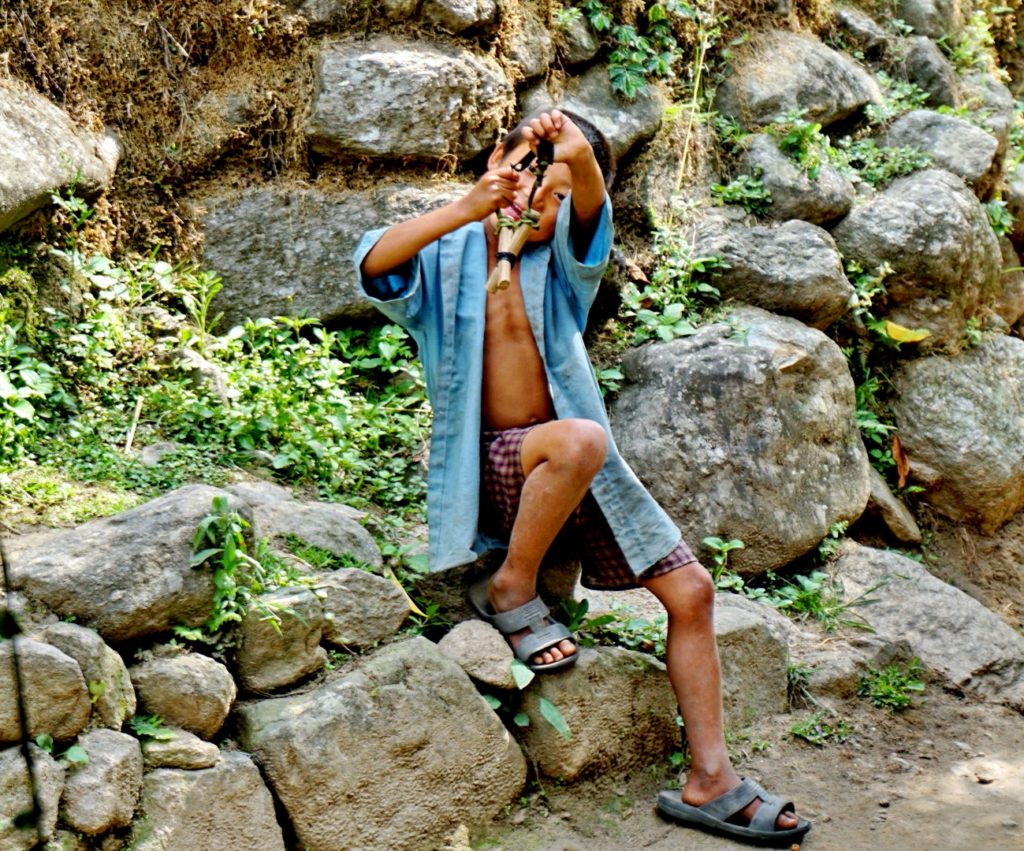
As I had previously experienced in Gudel, in Dangmaya I felt an incredible sense of peace, a warmth and fuzziness no doubt boosted the strong homemade raksi that Desh continued to procure for me. Desh had plans to walk out to his home in Tumlingtar and on to the distant village of Chichila, where his own wife had grown up. He cajoled me to join him for a few more days trekking, keen to continue practicing his English and for me to meet an Englishman living with a local family above Khadbari. The drowsy charm of Rai village life was sucking me in. It had not escaped my attention that this place was not marked on any map and my whereabouts was now unknown to the world. Thoughts of staying here, disappearing from the outside world, played seductively across my mind. I was aware that this was vaguely the premise of Hilton’s Lost Horizon – had I finally found the actual Shangri La?
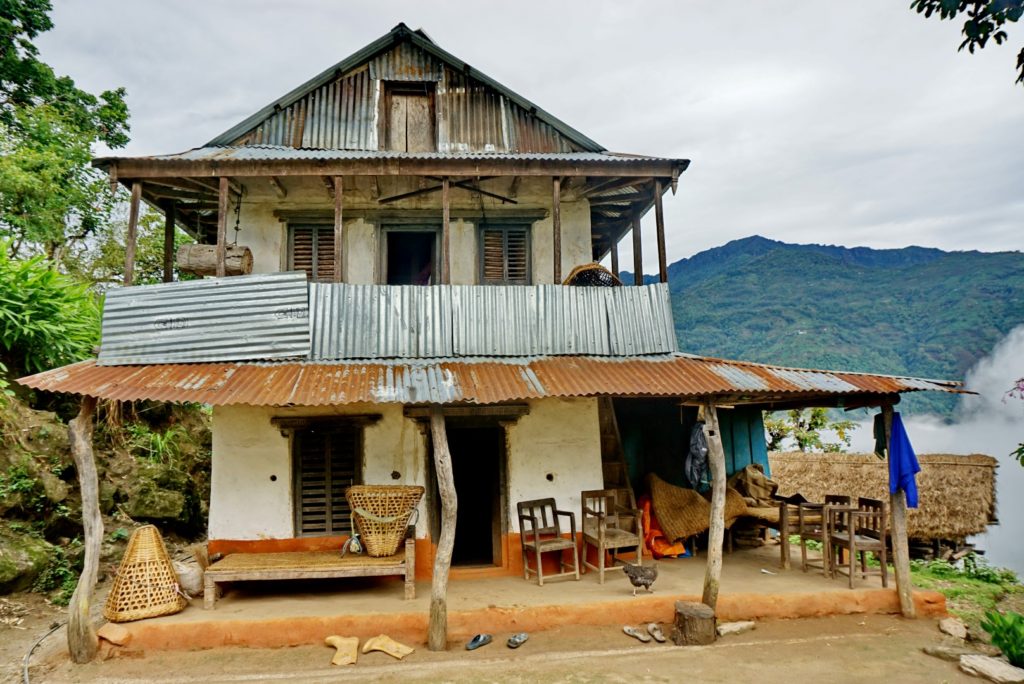
On foot, Desh was the archetypal Nepali: quick, sure steps, casually attired and indefatigable. His appetite for conversation was also inexhaustible, sharing his thoughts on politics, philosophy, family, art, agriculture, business, quizzing me on the European viewpoint on each. He was abuzz with entrepreneurial plans for planting more cardamons (a valuable cash crop) and building a hostel to attract tourists. He exuded a natural, easy charm that enabled him to strike up conversation with everyone we met on the trail; within moments of meeting he could draw laughter from schoolchildren, old ladies and burly labourers alike. When my conversation ran a bit dry and passersby were scarce he would take to his phone. He preempted my every need, procuring us food and drink, arranging boiled water for coffee every morning unprompted (he never touched coffee or alcohol). The week I spent as his guest was a rare privilege, giving me insight into Nepali life and culture that I could not have hoped to glimpse otherwise. I am forever in his debt. In fact Desh was to do me one more incredibly generous turn, as he arranged for his family in Kathmandu to accommodate me when I returned there to organise the next stage of my trip.
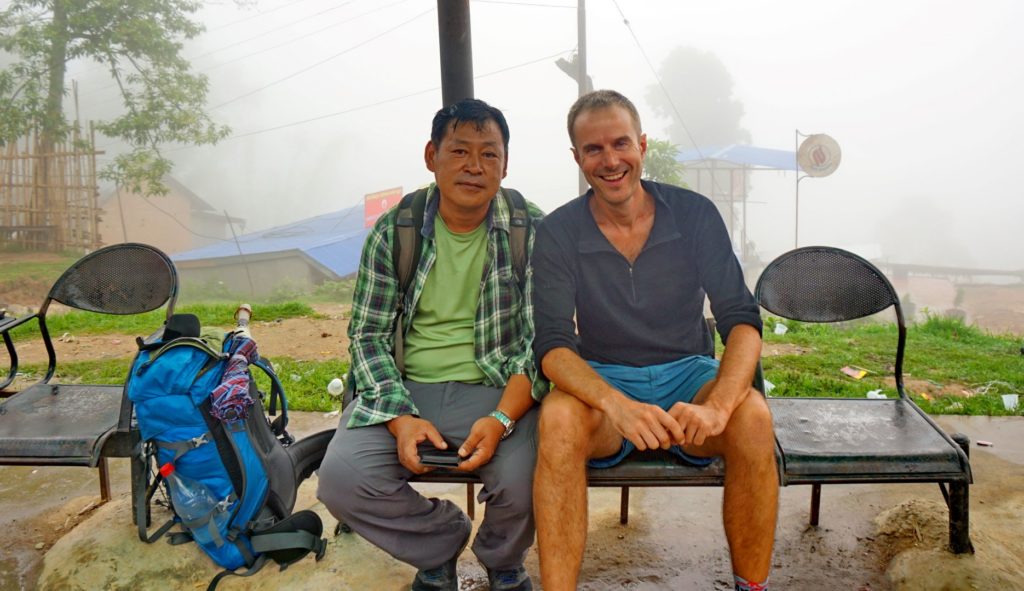
Satisfied that I had sucked the marrow out of my time in the Nepal Himalaya, I was ready to make the inevitable long haul back to Kathmandu. The nine hour bus ride into Jiri all those weeks ago had, at the time, seemed like the limit of human endurance. To get out, I now faced a seven hour jeep ride followed by a nineteen-hour bus journey. A distance less than 200km as the crow flies took twenty-six spine-crushing, cranium-concussing hours via Nepal’s tortuous rural road network. I arrived in Lalitpur, south Kathmandu, bruised and shattered, vowing never to set foot on a bus again. There Desh’s eldest son, Kabiraj, younger brother, Lax, and soon-to-be sister-in-law, Christina, took me under their wing and made it hard to even think of leaving Kathmandu. The Indian Embassy saw to that, though. My application for a six month visa for India was turned down and only three months approved. Worse, it started on day of issue, when I was still three weeks away from the border. My tranquil interlude in the sanctuary of the Nepal was officially at an end. It was now game on to get back on the bike and into Northern India, where some of the highest roads in the world awaited.
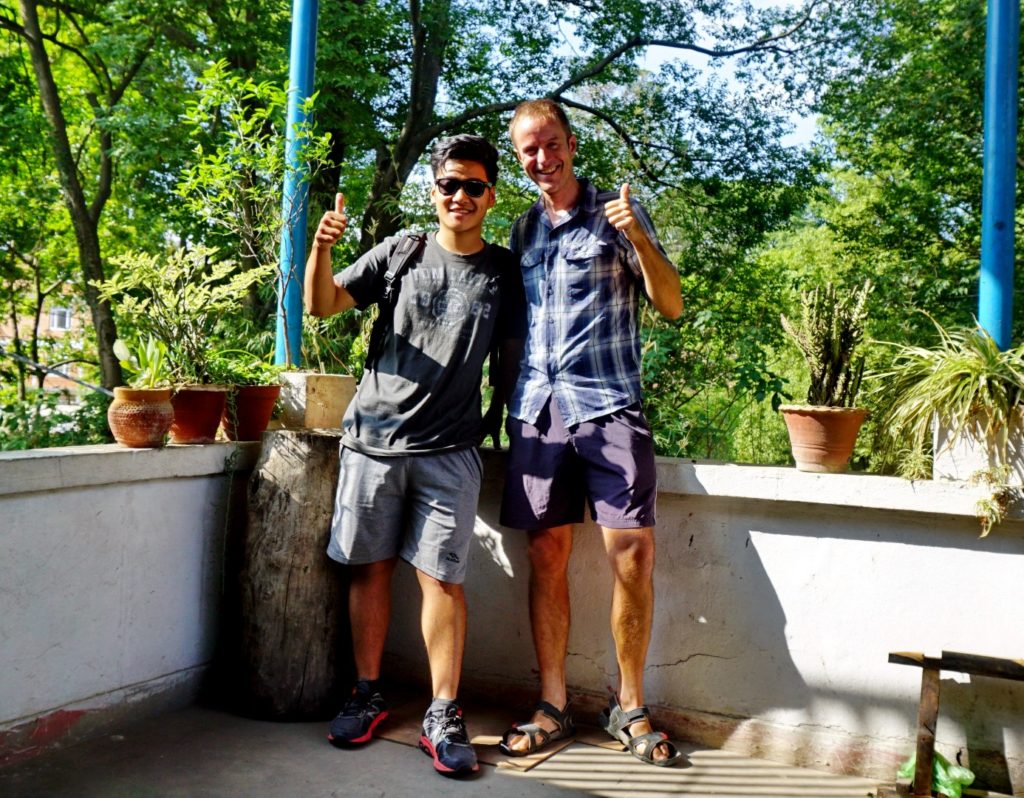
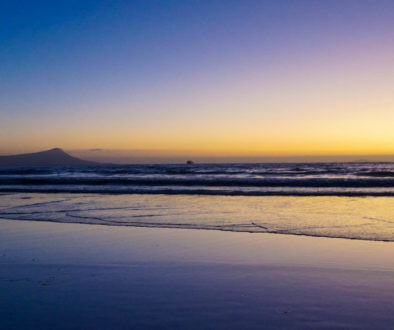
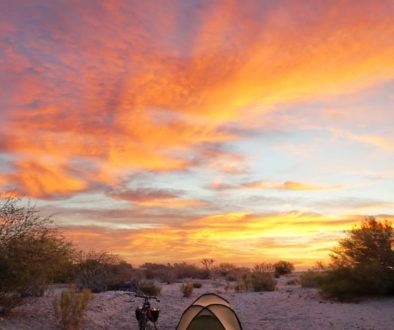
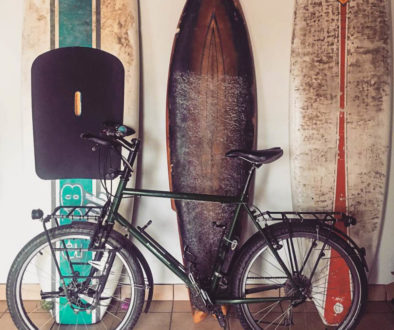
15 April 2018 @ 04:59
Awesome Writing! Nice to find a great blog of 3P, EBC and Arun Valley exit .. all-in-one!!
26 April 2018 @ 06:11
Thanks for the comment, I’m glad you found it interesting. Nepal was one of my favourite countries on my trip to date. More stories coming soon!
20 February 2017 @ 14:11
As always, Dan, your writing style completely transports me into your surroundings. Grand! Can never wait for the next instalment.
20 February 2017 @ 00:00
Worth the wait Dan! Look forward to the next instalment.
16 February 2017 @ 22:07
Well done you’ve captured the essence of the more popular tourist locations and something of the more mundane, everyday life of a rural Nepali citizen.
16 February 2017 @ 19:36
Yep – worth the wait Dan . I love the writing style . Does it come as way as it looks ?
16 February 2017 @ 18:28
I agree with Tara. Great read Dan.
Glad you found time to do some writing.
Looking forward to hearing/reading about India.
16 February 2017 @ 12:36
Wow. Stunning writing, stunning photos. I especially loved the atavistic Tubular Bells experience and Pemba and his wife singing – hauntingly beautiful. It seems like Nepal really made its way into soul and I can feel it through the writing. Worth the wait! xx